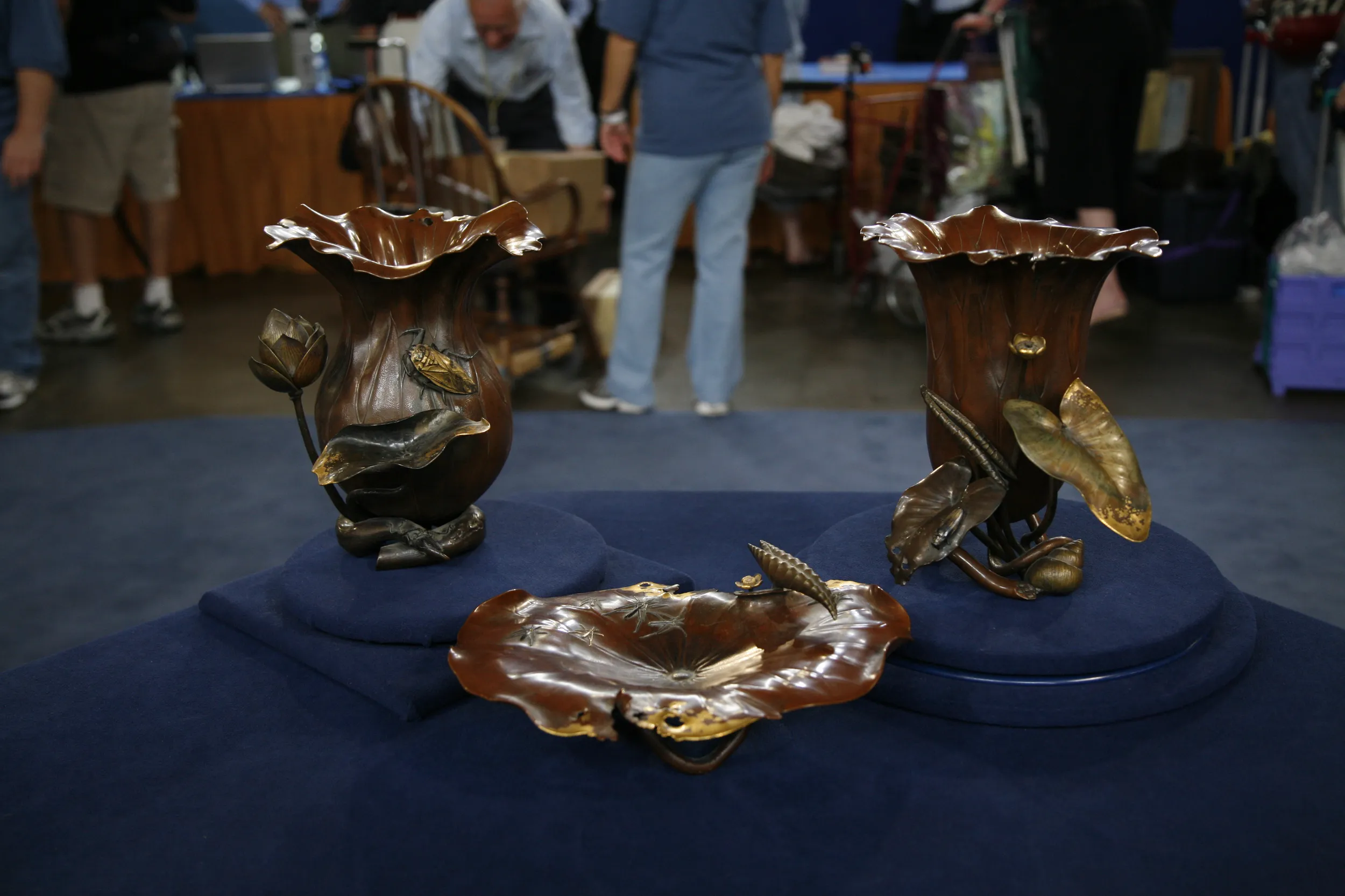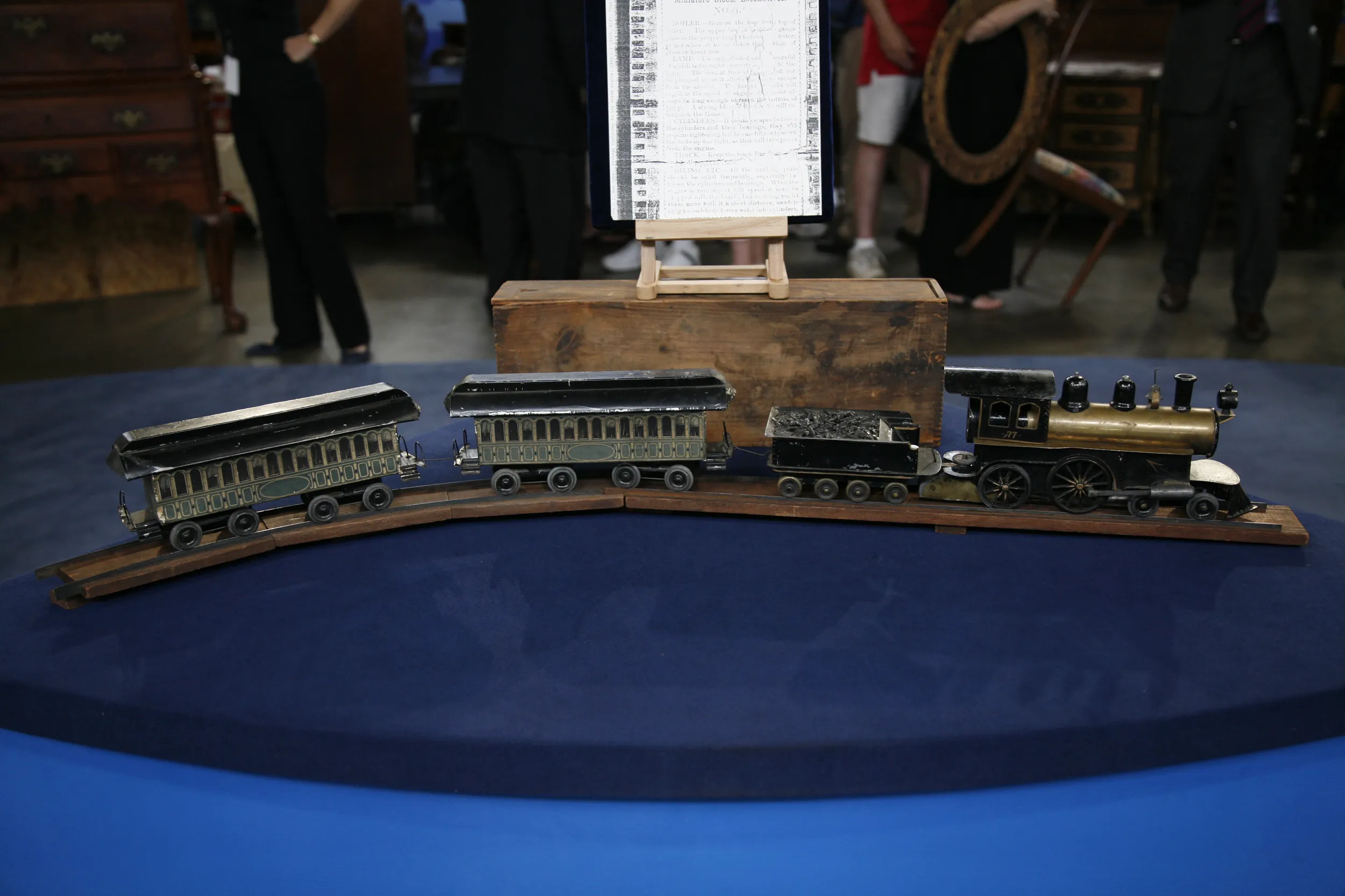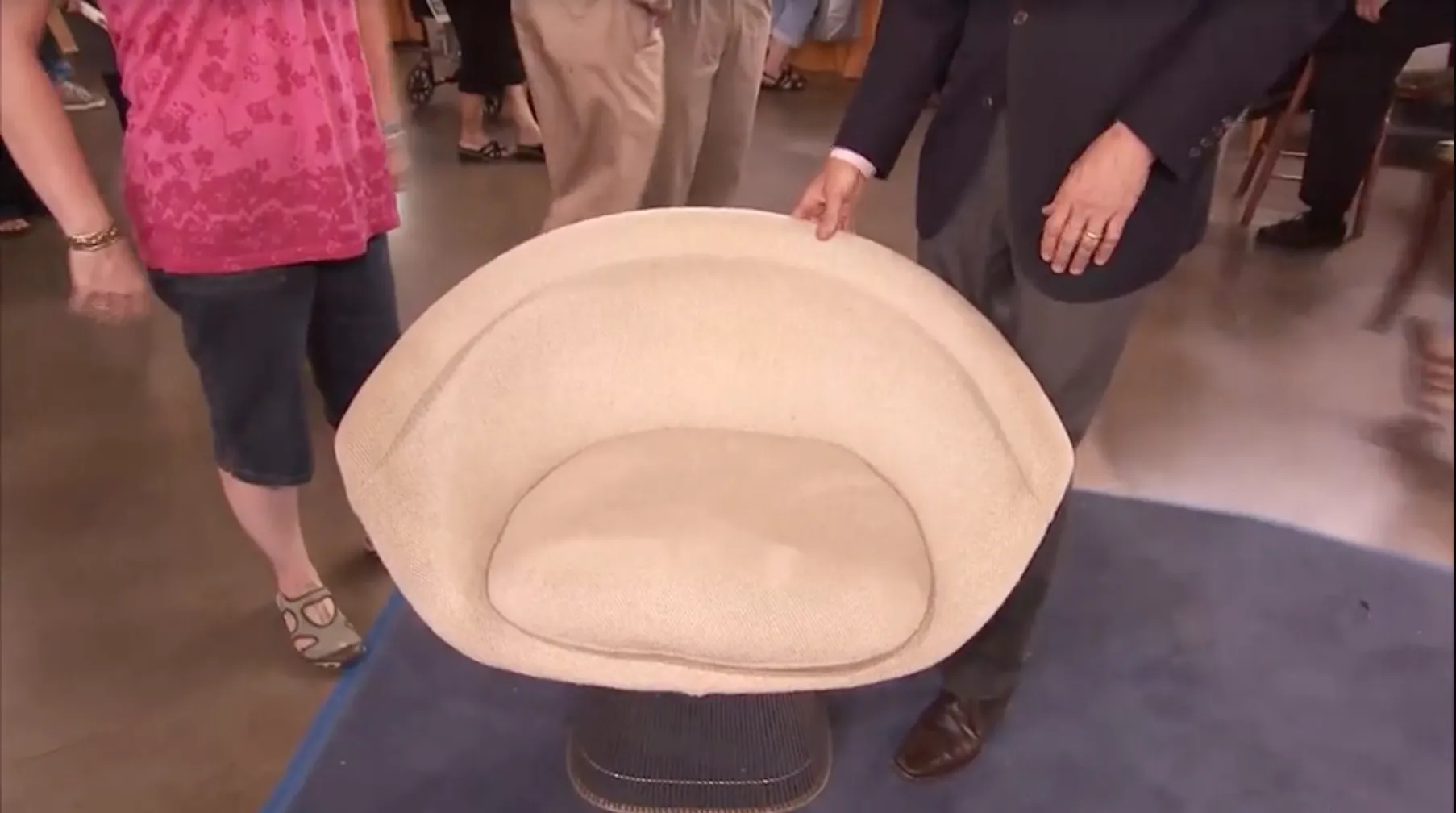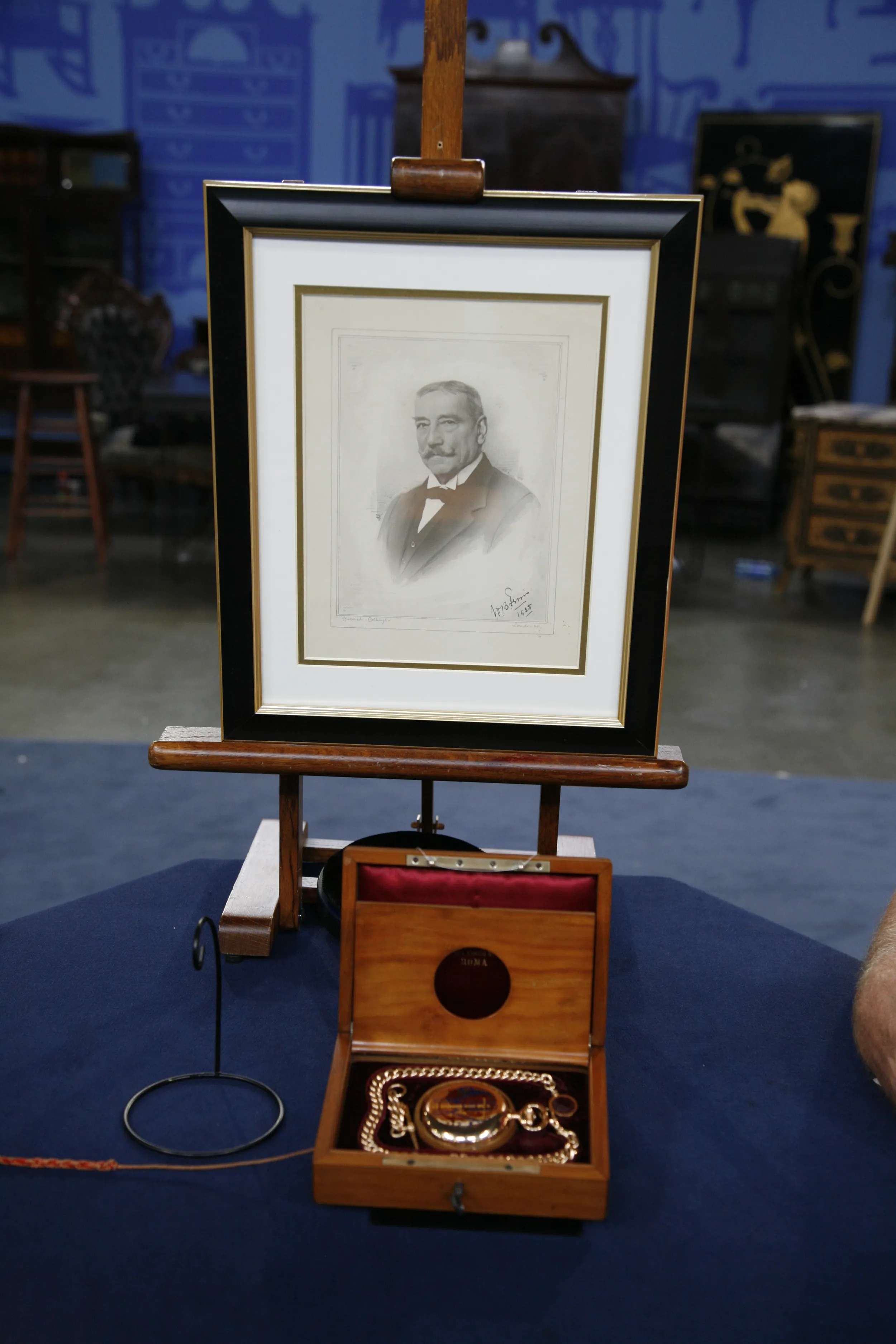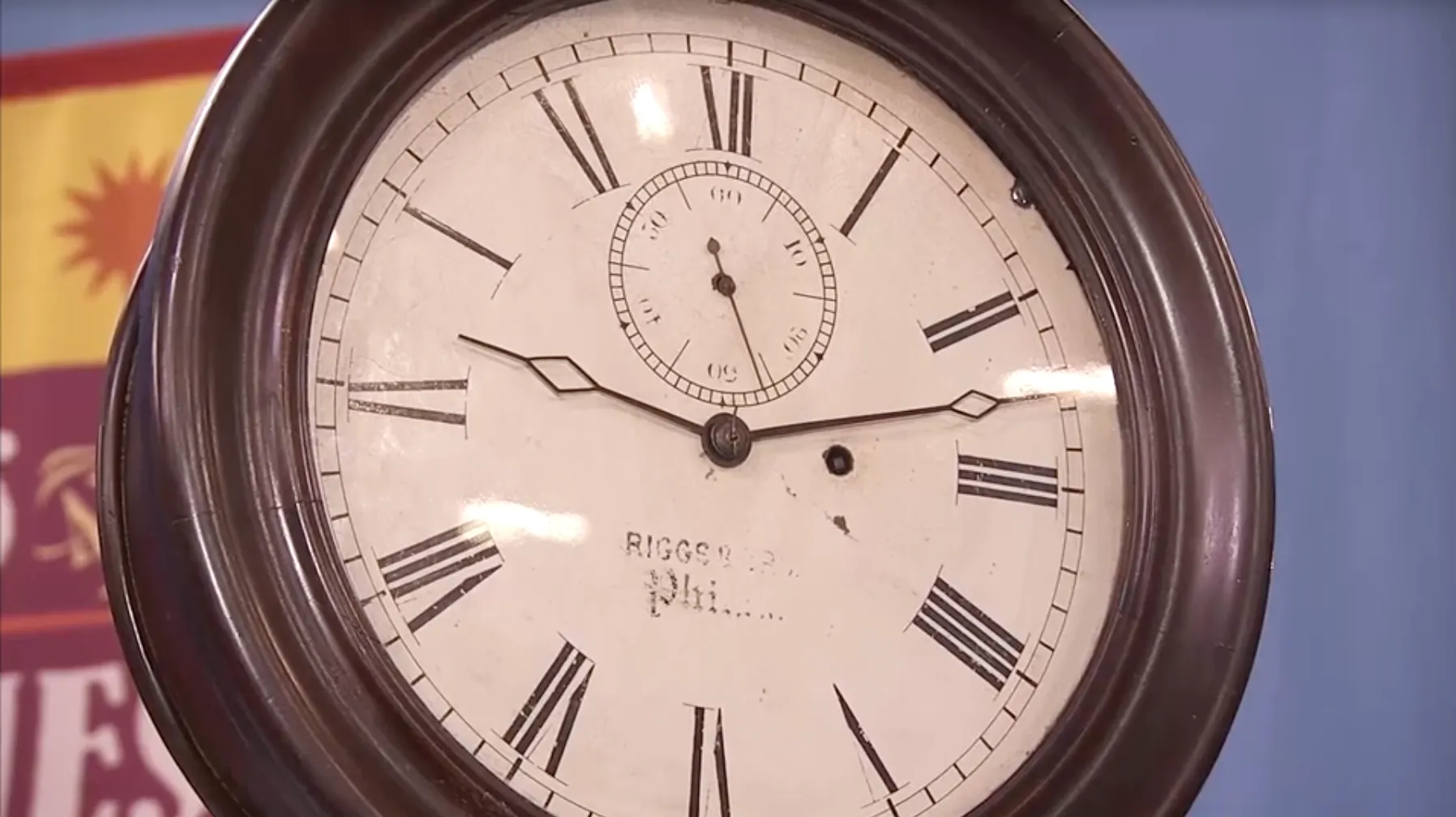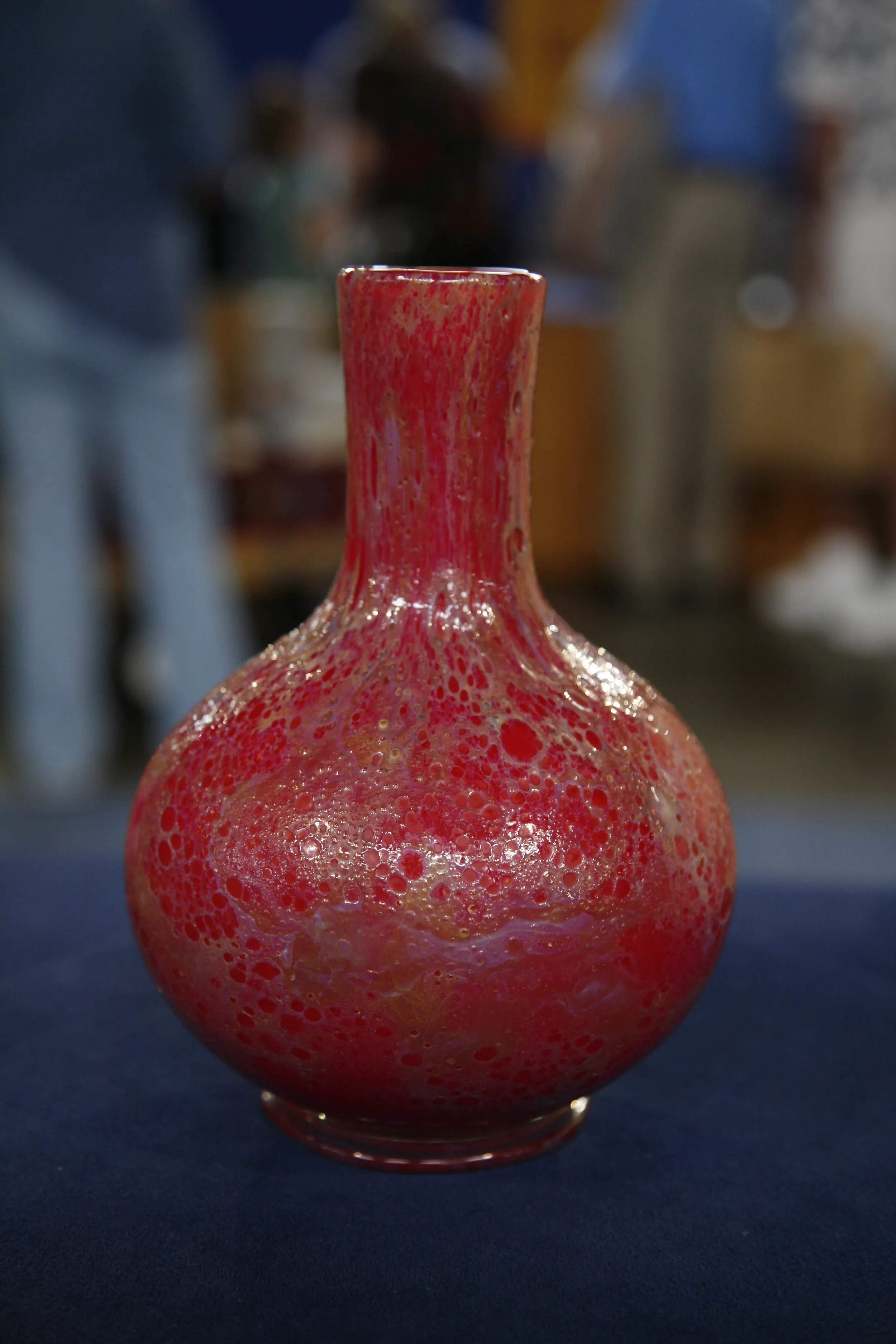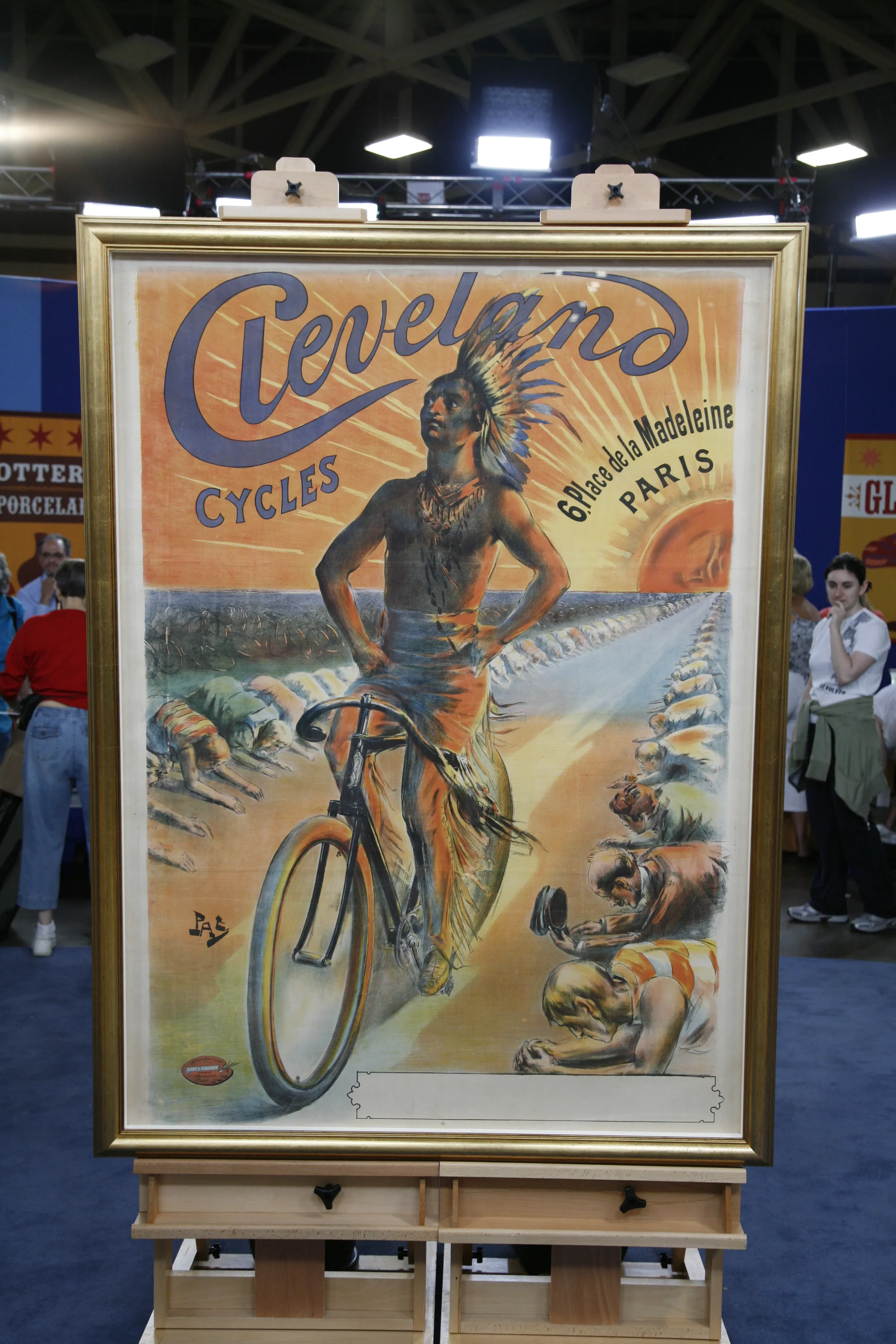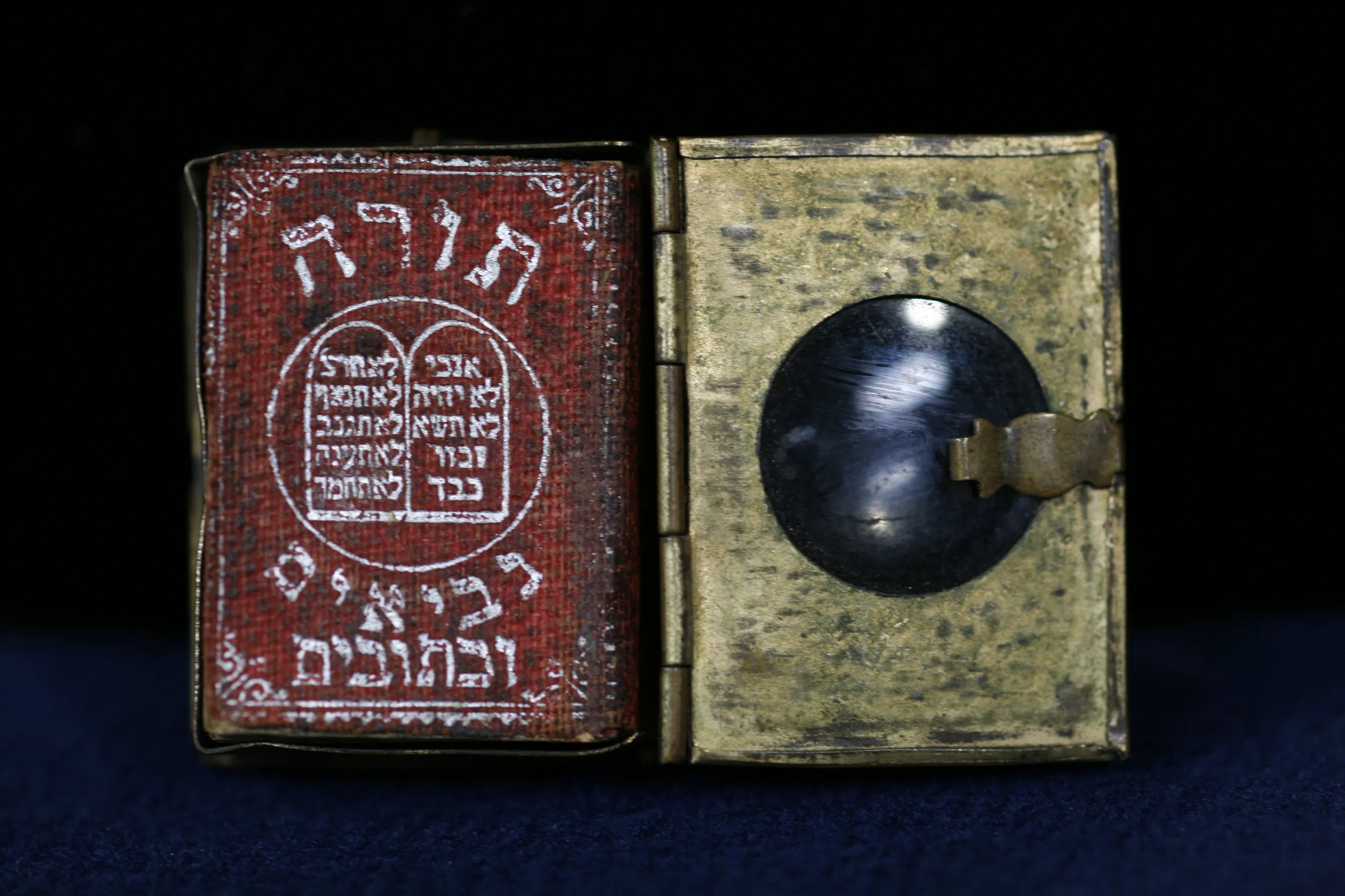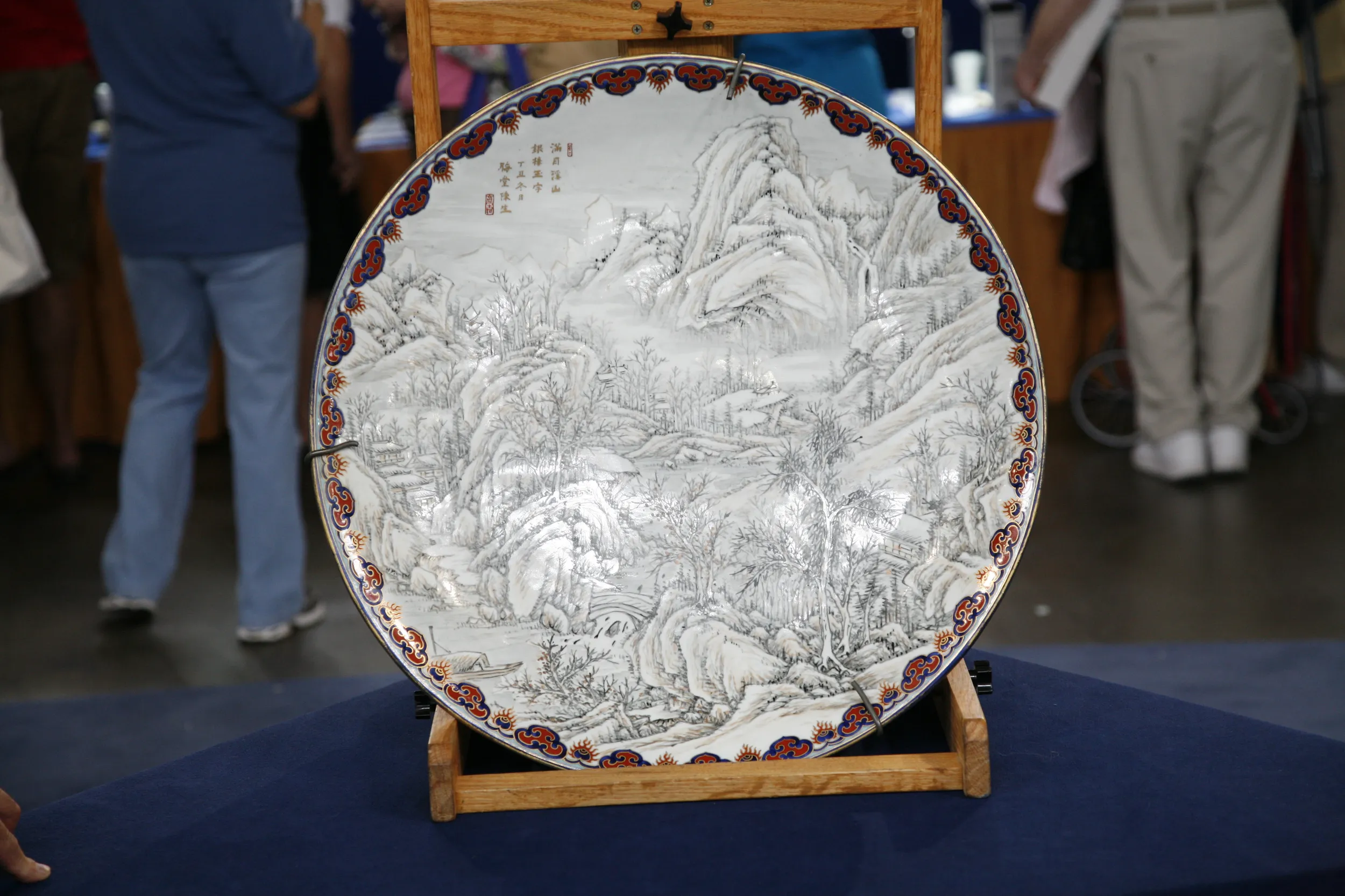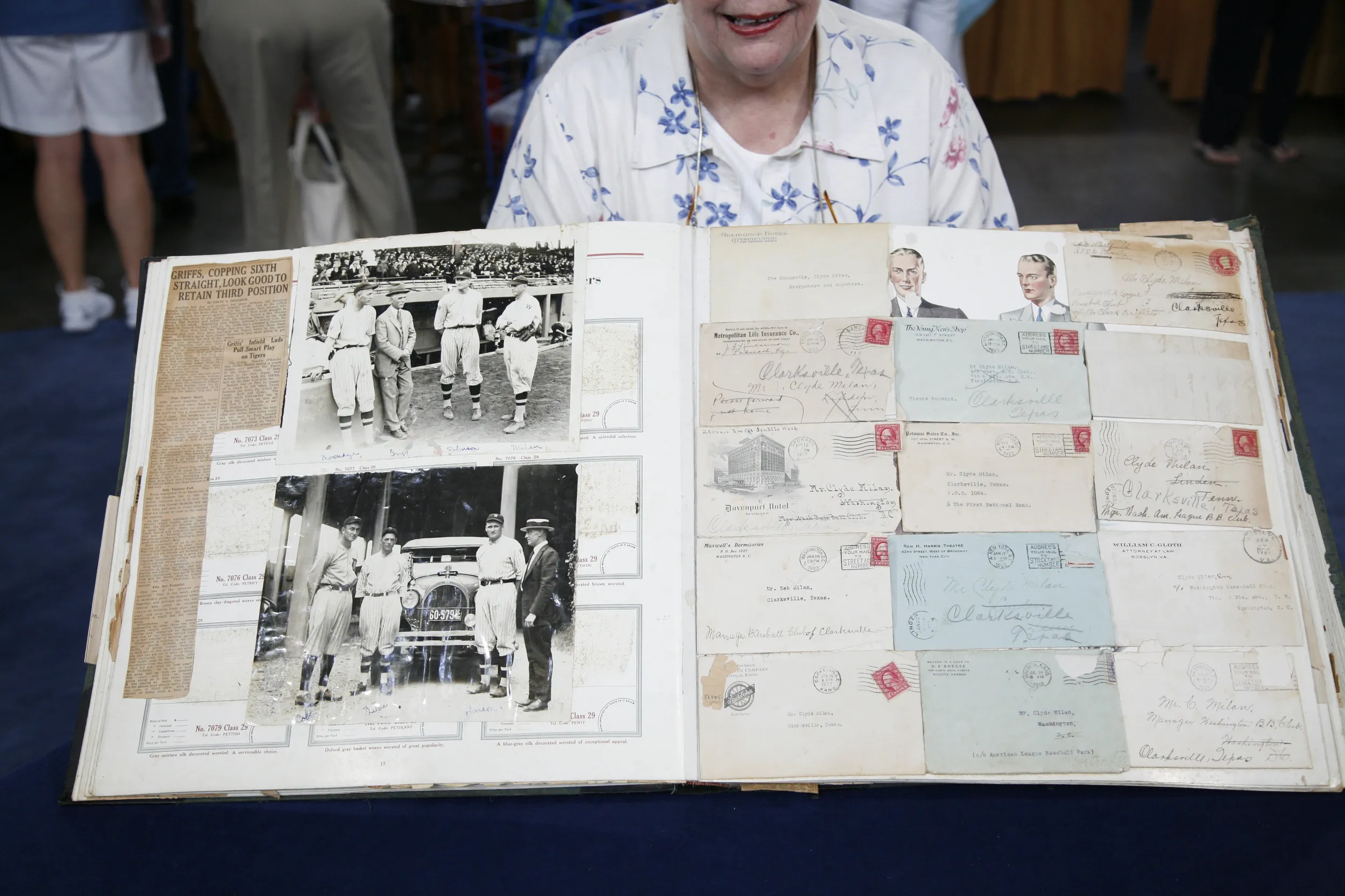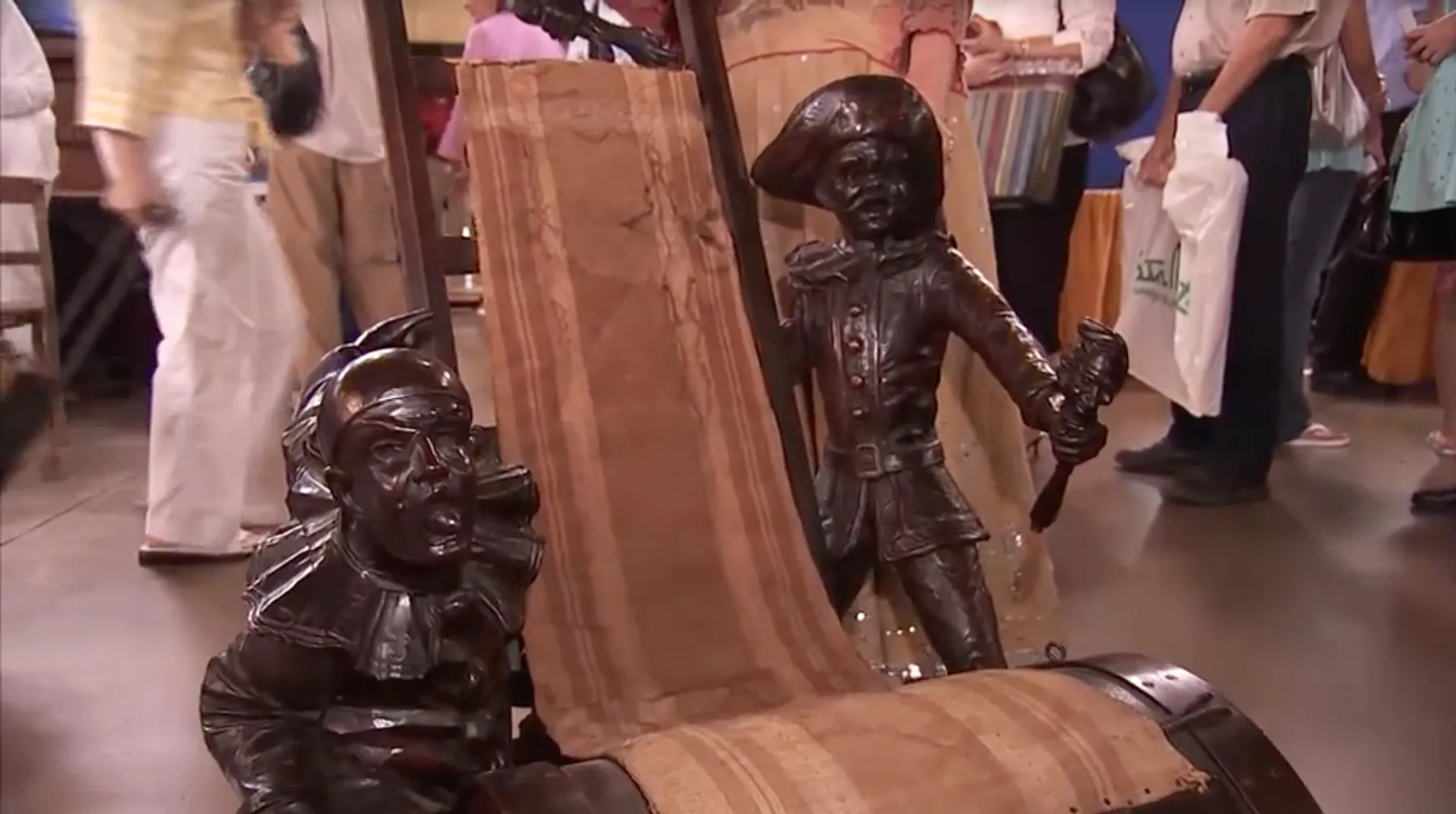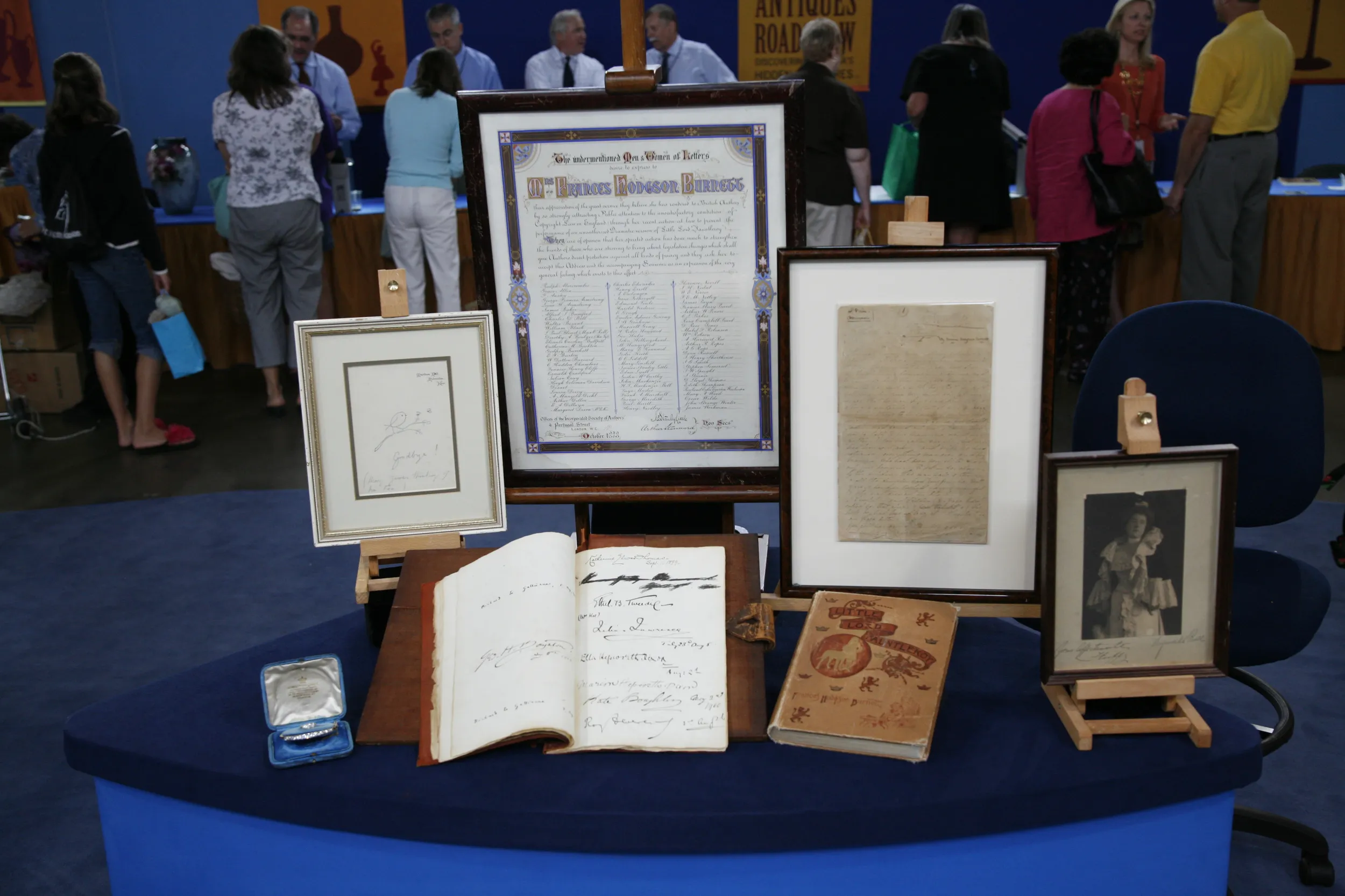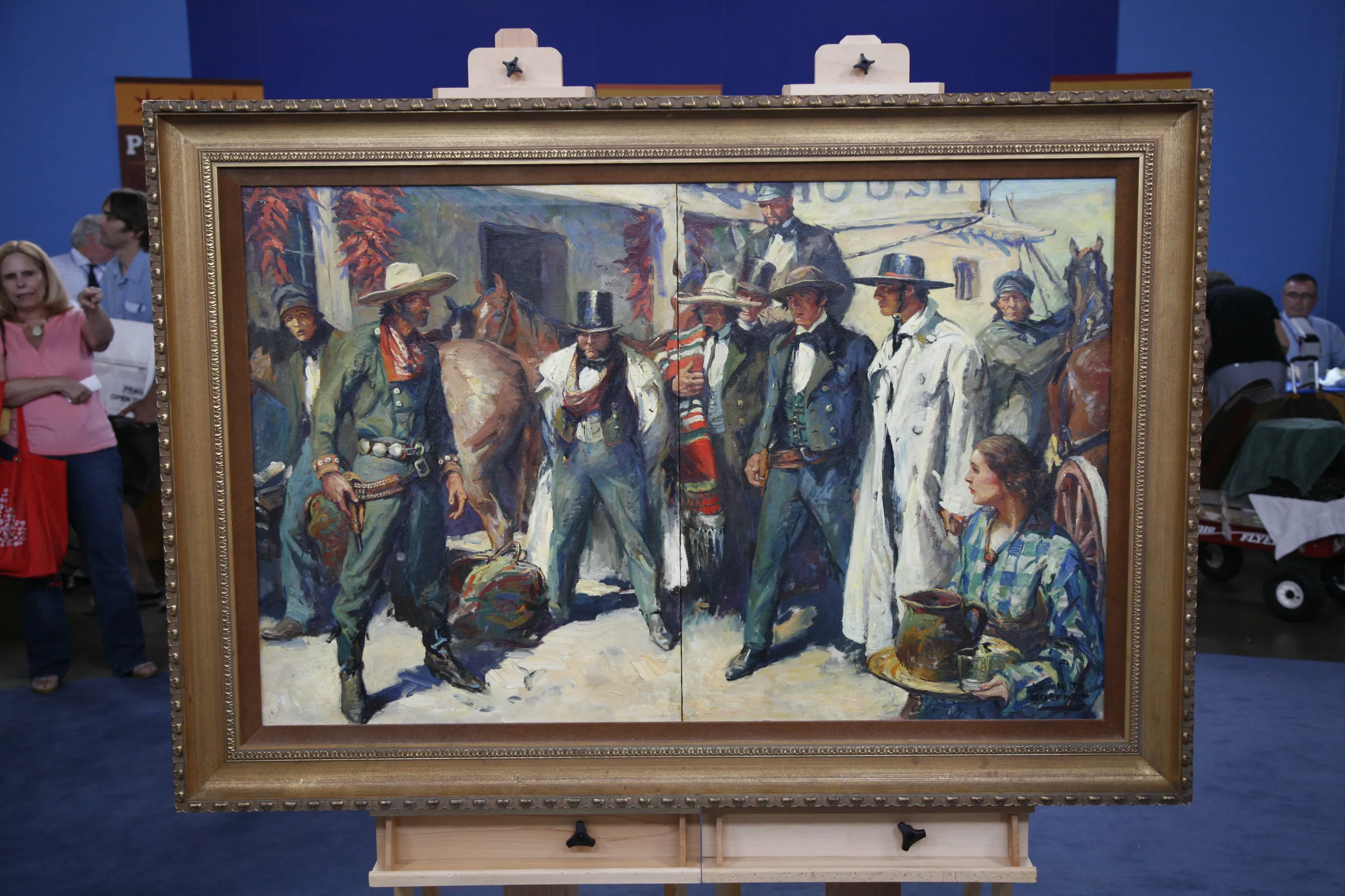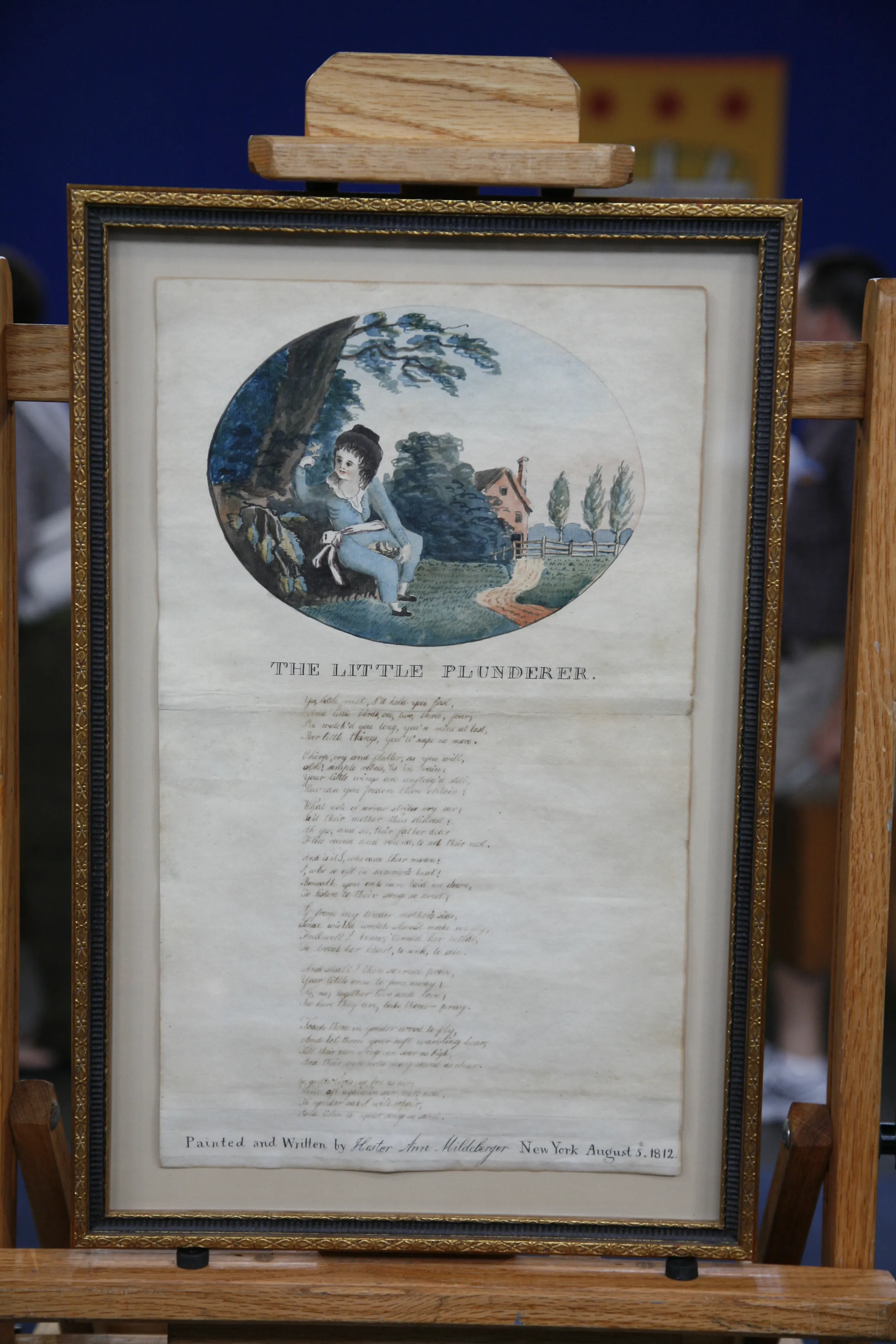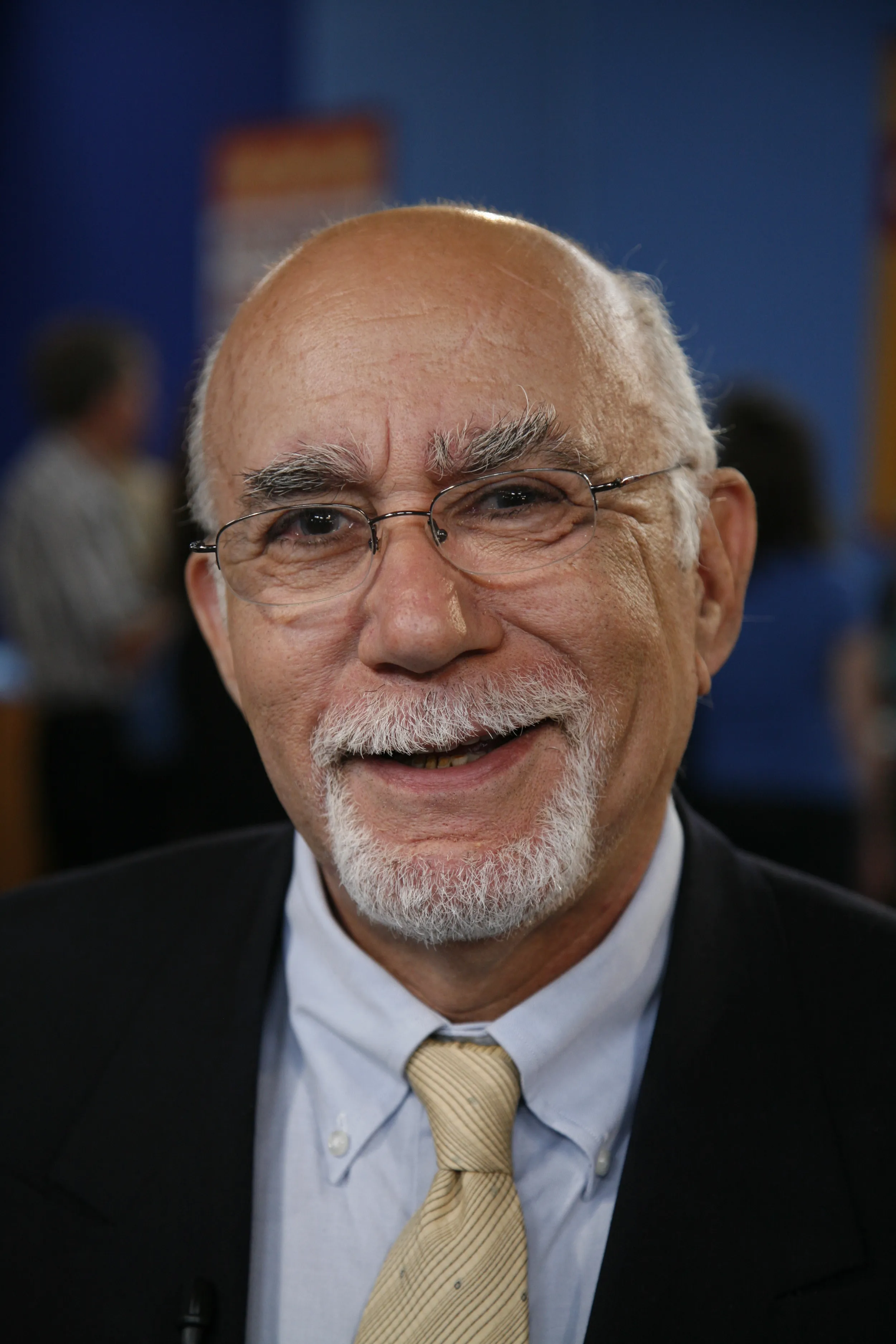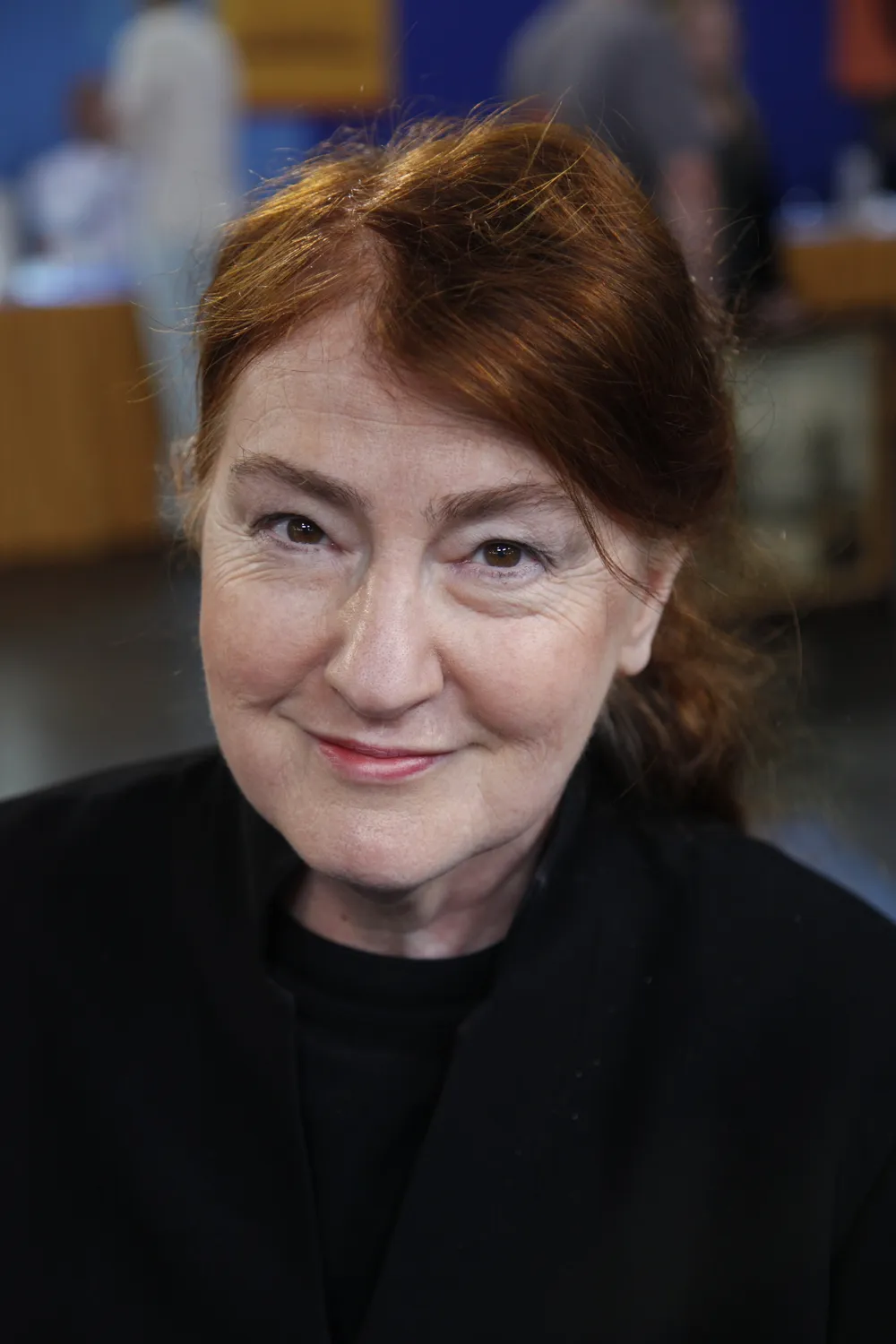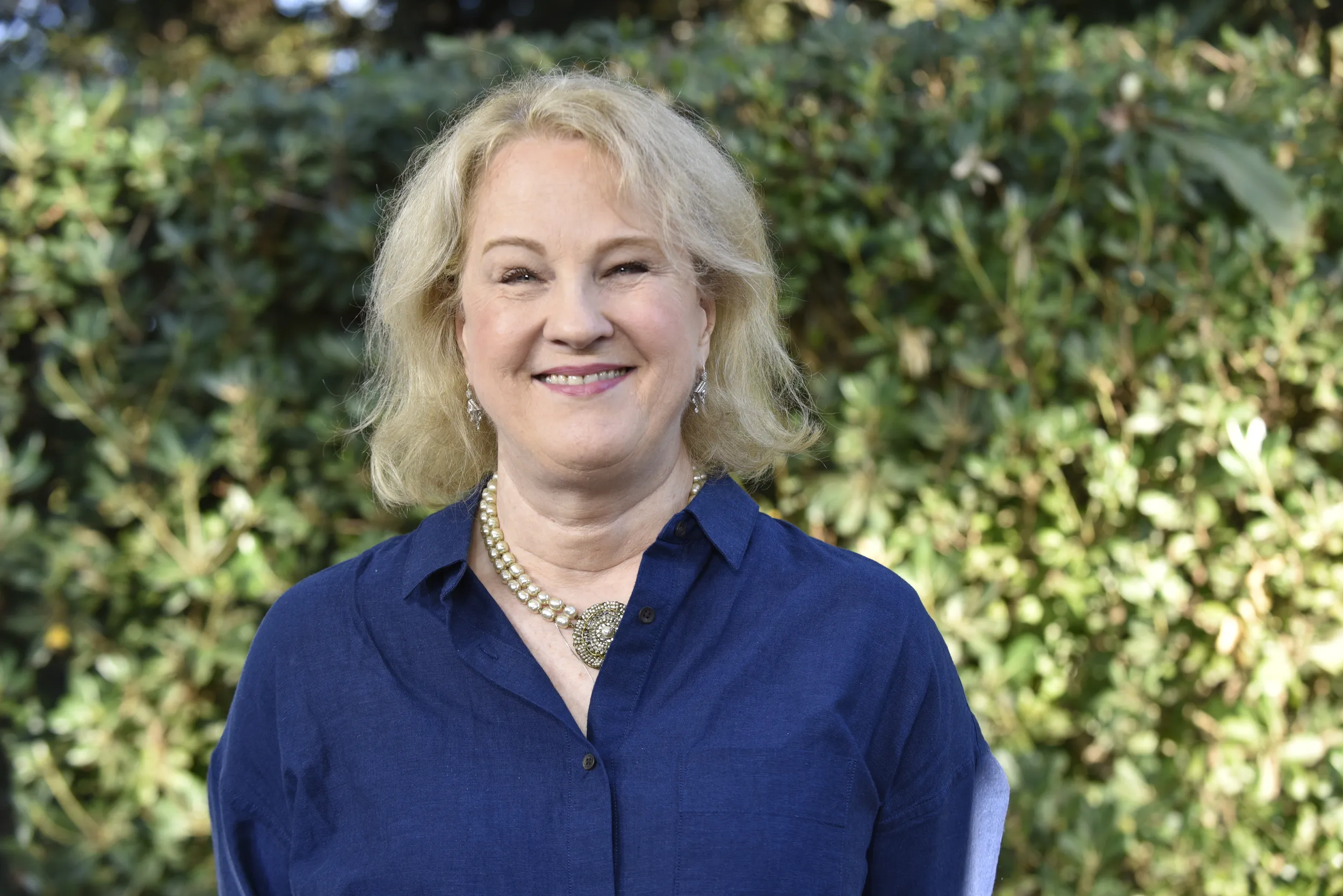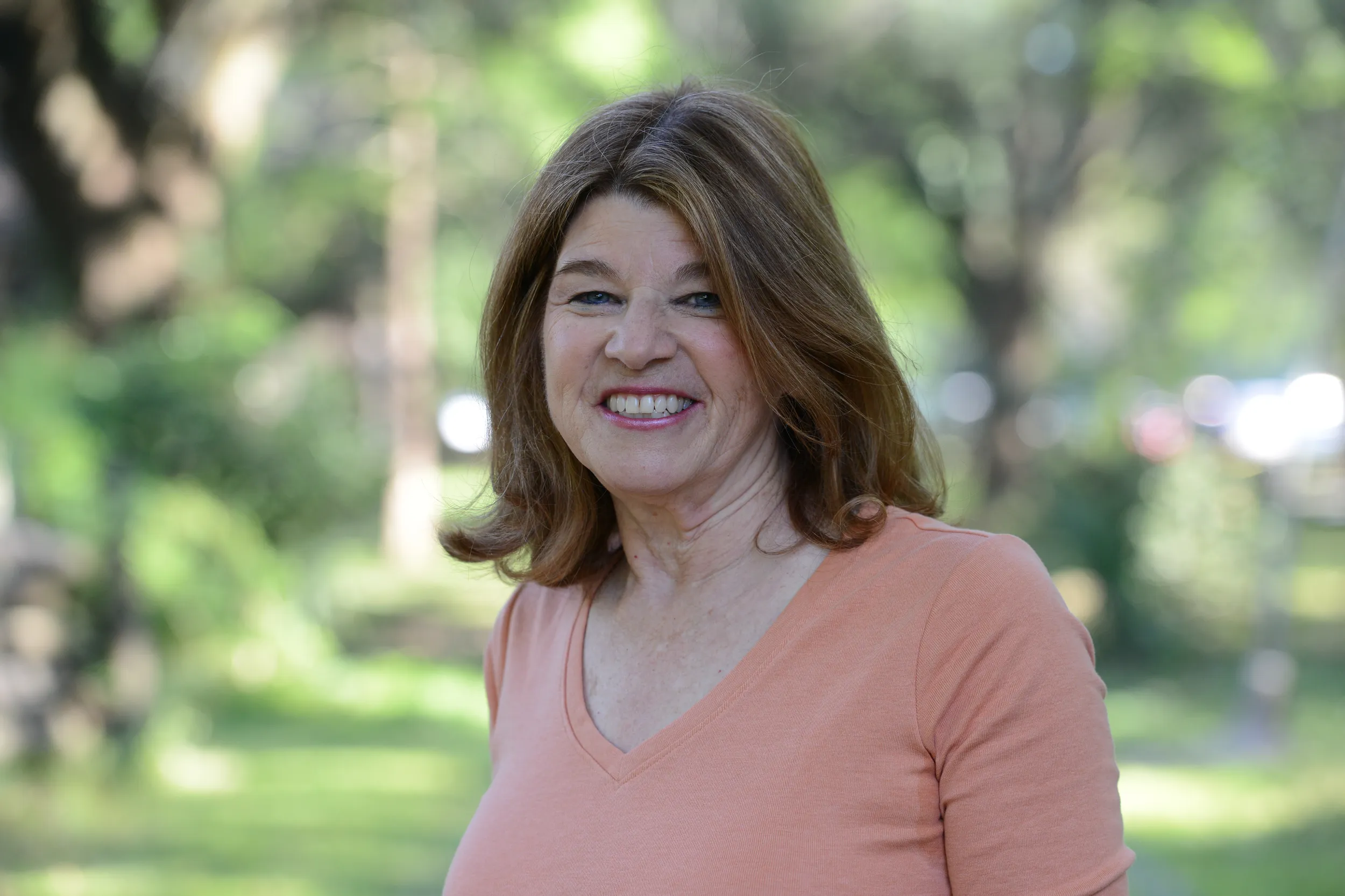APPRAISER: You can only have one number one.
GUEST: That’s right.
APPRAISER: And it's sittin’ on this table.
GUEST: Oh, my. (laughs) I don't know what I'll put in it now.
APPRAISER: (appraiser laughs)
GUEST: Looks like something's fixin' to happen.
GUEST: Yay! (chuckles)
HOST: With a state motto of "Friendship," Texas warmly welcomed ANTIQUES ROADSHOW 15 years ago in Dallas. Friendly faces greeted us from near and far with their fantastic finds...
APPRAISER: $2,000 in a flea market?
GUEST: Uh-huh.
APPRAISER: You actually paid $2,000.
GUEST: Yeah-- they take checks. (both laugh)
HOST: ...and family heirlooms.
GUEST: This is actually a pocket watch that was given to my grandfather.
HOST: We found many stars in the Lone Star State.
APPRAISER: It's a wonderful image, it's great condition, and I'm, I'm really glad you brought it in.
GUEST: Thank you.
HOST: But do they still shine today? Find out in this hour of "Vintage Dallas."
GUEST: I took my husband to his first serious antique flea market in Dallas, at Fair Park, and that's where I found them, just as I walked in the door. (laughing): Literally.
APPRAISER: What attracted you about them?
GUEST: Um, I love Art Nouveau things. I, I collect Art Nouveau jewelry, so, um, I love the three-dimensional aspects of it. It has insects on it, because I collect bug jewelry. (laughing) It has, you know, a lot of florals, and, um, just very three-dimensional.
APPRAISER: They are made in the Meiji period, which was from 1868 to 1912. They're actually done by a pretty major swordsmith artist...
GUEST: Oh, mm-hmm.
APPRAISER: ...and metalworker by the name of Shoami Katsuyoshi. He lived in Okayama Prefecture, which is part of the main island, uh, Honshu island, sort of in the western portion. Here's the signature. It says Shoami Katsuyoshi, with a kakihan here.
GUEST: Uh-huh.
APPRAISER: Actually, on this piece, in the back, it has a fuller inscription.
GUEST: Mm-hmm.
APPRAISER: It says "Dai Nihon," which means "made in the great Japan."
GUEST: Mm-hmm.
APPRAISER: Which means during the Meiji period. And then the artist's name.
GUEST: Oh, wow.
APPRAISER: And Katsuyoshi, his dates are 1832 to 1908.
GUEST: Okay, okay.
APPRAISER: And he moved from making sword furniture to large vases...
GUEST: Mm-hmm.
APPRAISER: ...after there was a prescription against wearing swords at the beginning of the Meiji period.
GUEST: Right, yeah.
APPRAISER: So, I mean, these are phenomenal pieces in terms of their execution. You have copper; you have shakudo, which is a combination of gold and copper; a little bit of shibuichi, which is silver and copper; and also some pure gold here.
GUEST: Mm-hmm.
APPRAISER: The interest in the natural form, in birds and blossoms and bugs, was really quite prevalent among these Meiji period artists.
GUEST: Mm-hmm.
APPRAISER: It was amazing when I saw these, because normally, you'll see one piece.
GUEST: Yeah.
APPRAISER: But not three.
GUEST: Yeah.
APPRAISER: The power of this set is really in, in that it's a set. What did you pay for them?
GUEST: $2,000, about $2,000.
APPRAISER: $2,000 in a flea market?
GUEST: Uh-huh.
APPRAISER: You actually paid $2,000?
GUEST: Yeah-- they take checks. (both laughing)
APPRAISER: That's...
GUEST: Checks works fine.
APPRAISER: Well...
GUEST: But I knew they were really unusual, that, but I didn't know anything-- that's all I knew.
APPRAISER: In the current market, this set of pieces is worth between $20,000 and $30,000.
GUEST: (laughing): Oh, my...
APPRAISER: At auction.
GUEST: (laughing): And I had to really prod my husband to buy.
GUEST: This was given to me by my Uncle Bob. He was an engineer, and he gave it to me when I was about eight or nine years old.
APPRAISER: And he played with it, probably, before you?
GUEST: Well, it had a lot of soot in it, so I'm sure he did-- somebody did.
APPRAISER: You're originally from...?
GUEST: I'm originally from the Paterson, New Jersey, area.
APPRAISER: Which is where this train was made.
GUEST: Exactly.
APPRAISER: Well, it's a great train, and you know who made it.
GUEST: I was told the Beggs Machine Company, but I was not able to find anything out about the Beggs company. I got that from the Passaic County Historic Society, which also has one of these trains, but they also had the, uh, instructions, which I do not have. The instructions were glued to the box, but they've since worn away.
APPRAISER: Well, you know, we love boxes, and I'm sorry the, uh, label's not there, because that helps make the box a little bit better, but here it is, in the box. In Europe, they had some toy trains prior to this that were steam-powered. Well, Eugene Beggs, in 1871, made, got a patent for an improvement on toy trains, and this was his design for the American market, the American profile with the cow catcher, and actually run just like the big ones, on steam, with the hot water into the steam chamber driving the wheels, and it was made from the 1870s into the 20th century. This is one of the earlier sets, and it was a very, very popular toy. Very expensive toy in its day.
GUEST: Really?
APPRAISER: What's amazing about this is, one, it's in extraordinary condition. These cars are actually made of lithograph paper cardboard with very light tin tops. This didn't have a lot of power to pull some heavyweight cars, so they were very clever in producing these very realistic-looking passenger cars with lithograph paper. And, of course, paper is a rather fragile commodity, especially when you have a train that's being run with hot water. You get the paper wet...
GUEST: Yeah.
APPRAISER: ...you don't have much left. Another very interesting aspect is, it has this eight-wheel tender, and it also has the original coal load. This train, as they got later in the production, they put a little tender on here, just a very simple little thing, all one piece, to make it cheaper, easier to make.
GUEST: Okay.
APPRAISER: So it's very rare with the full-size tender. Now, you had a story about, you tried it one time.
GUEST: Well, my buddy and I set it up in the basement. We didn't have any alcohol, which you're supposed to use for the fire, but we did have some lighter fluid.
APPRAISER: (chuckling): Oh, my God.
GUEST: So, we put lighter fluid in it. We lit the four wicks, and we were very anticipatory of it running, until it started hissing. And I was afraid it was going to explode, and so I blew out the wicks.
APPRAISER: Yeah.
GUEST: I wasn't worried about it hurting me or the house, I was afraid I would lose my train.
APPRAISER: Well, I, I think you made a wise choice to stop. Lighter fluid is not quite what is called for here.
GUEST: (laughs)
APPRAISER: You did have someone appraise it once?
GUEST: I sent a picture of it to a, uh, an appraiser, and they sent back an appraisal of $500. That was about 30 years ago.
APPRAISER: I'm not sure what it was worth 30 years ago, but today, at auction, this train would conservatively bring somewhere, I would say, around $5,000 to $7,000.
GUEST: Wow.
APPRAISER: In this condition.
GUEST: Very nice.
APPRAISER: This is stamped underneath, and the shade is stamped. It's perfectly good Tiffany lamp. These are linenfold panels.
GUEST: Oh.
APPRAISER: It's a very, very pretty lamp and it's, uh, 100% right.
GUEST: Well, I got ‘em from my employer.
APPRAISER: Okay.
GUEST: We remodeled back about ten, 12 years ago.
APPRAISER: Right.
GUEST: And they had a silent auction.
APPRAISER: Okay.
GUEST: And I was able to get 'em.
APPRAISER: Okay, what did you pay for them?
GUEST: Uh, I got four chairs and a coffee table for $80.
APPRAISER: In the same style? Okay.
GUEST: It's, it's a matching set. Mm-hmm.
APPRAISER: Okay, well, this is designed by Warren Platner and distributed by Knoll Furniture. Warren Platner was a very famous modern furniture designer. He worked with Eero Saarinen. He, he worked on great, famous buildings.
GUEST: Mm-hmm.
APPRAISER: And his, these chairs are sort of a symbol of modernist, uh, ni, mid-century furniture.
GUEST: Hm.
APPRAISER: The prototype for these wire chairs, which are steel, plated, uh, by nickel-- beautiful design...
GUEST: Yeah.
APPRAISER: ...uh, was made in 1966. This chair, we turn it over, we've got the Knoll International label.
GUEST: Yes.
APPRAISER: And, basically, it has the original fabric.
GUEST: Yeah.
APPRAISER: You have three more of these, you said?
GUEST: Yes, mm-hmm, mm-hmm.
APPRAISER: Okay, well, these are just beautiful.
GUEST: Thank you.
APPRAISER: I love this style myself. This type of furniture design, mid-century modern, is one of the hottest areas right now. I mean, young people are buying it, furnishing their homes. It's very, very trendy.
GUEST: Mm-hmm.
APPRAISER: Value on these, do you know? Do you have any idea?
GUEST: No idea.
APPRAISER: Well, this...
GUEST: More than $80, right?
APPRAISER: Okay, this one chair...
GUEST: Mm-hmm.
APPRAISER: ...is $800 to $1,200.
GUEST: Oh my.
APPRAISER: So multiply that times four.
GUEST: Four. Yeah, great.
APPRAISER: And you have what? 40...
GUEST: (laughing): That's not bad.
APPRAISER: (laughing): Not bad?
GUEST: Yeah, I'll take that.
GUEST: This came from my grandmother's home, upstate New York. The home was built back in the early 1800s, sometime between 1800 and 1820, on a Revolutionary War grant, a land grant. This came from the home. I really-- we always called it the "bread bowl."
APPRAISER: Well, in the business, we would refer to this as a "burl bowl."
GUEST: Burl bowl? Oh.
APPRAISER: A burl is on the side of a tree and it looks sorta like a wart, or a knot.
GUEST: Oh, yes, mm-hmm.
APPRAISER: And so, the guy that made this had to have a burl about that big...
GUEST: Oh, my.
APPRAISER: ...cut it off the tree...
GUEST: Mm-hmm.
APPRAISER: ...and then make a bowl out of it. And the thing about a burl is that it's very, very hard wood. And as you can see from looking inside of here, that the grain is all swirly...
GUEST: Mm-hmm, mm-hmm.
APPRAISER: Well, the reason they made it out of burl was because it, it would stay stable more so than a straight grain would.
GUEST: Mm-hmm.
APPRAISER: Because all that grain was intermingled. The time period fits perfect with what you're saying-- 1815 or '20.
GUEST: Oh, my.
APPRAISER: I looked for lots of wear on the inside. You can see where they used tools on it and they put dough in it-- they just used it. That's what you want to see. Now, the other thing about this one is that it was turned on a lathe. If you look real closely, you can see the rings underneath here, and if you run your hand over it... Can you feel how uneven that is?
GUEST: Oh, oh, my, yeah. I never noticed that.
APPRAISER: The other thing that is great about it is that it has an oval shape. When it was made, it was perfectly round.
GUEST: Oh.
APPRAISER: But over the years, it expands and contracts, and it'll contract one way against the grain more so than another, so what was perfectly round becomes oval.
GUEST: Mm-hmm.
APPRAISER: I showed this to a couple of the other guys and we think it's made out of ash. You hear us talk about surface on the show all the time.
GUEST: Uh-huh.
APPRAISER: For some things, it's not as critical as others, but in a burl bowl, that's very important. It has a nice old surface. Now, where do you have this in the house?
GUEST: Well, it was sitting on top of our big old TV, holding, uh, DVDs and videotapes.
APPRAISER: (laughs) Really?
GUEST: Yes.
APPRAISER: You got a big, wide spot on top of the television?
GUEST: Yes, and I think... Yes, I still have one of those old TVs. (laughs)
APPRAISER: Would you put less DVDs in it if I told you that, in a retail setting, this bowl's worth $6,000?
GUEST: Oh, my-- oh, my. (laughing): Oh, my. I don't know what I'll put in it now. (both laugh)
APPRAISER: You might want to at least put it somewhere where you won't knock it off on the floor.
GUEST: (chuckling): That's right.
GUEST: This is actually a pocket watch that was given to my grandfather, who's here in the picture; he's William Butler Ferris. And he was the British consul in Aden, around 1896 timeframe, and when the Italians invaded Abyssinia, it didn't go well for them, and all their prisoners of war were going to be executed, and he helped negotiate their release. And in return for that, the king of Italy authorized this watch to be awarded to him.
APPRAISER: Quite fantastic-- well, let's go through a little bit about the watch. Fairly nicely engraved, and enameled up, with initials on the front cover. And the initials, uh, read...?
GUEST: It's William Butler Ferris, W.B.F.
APPRAISER: This piece is made by a company called LeCoultre, a famous Swiss watchmaking company. One of the interesting aspects about it, it is not only a minute repeater. So it will chime the time to the nearest minute upon request.
GUEST: Right.
APPRAISER: Chimes at the hours, the quarters, and then the minutes.
GUEST: Right.
APPRAISER: This was designed so that you could know the time, um, in the evening or when there was no light available.
GUEST: Right.
APPRAISER: It also has a chronograph, as well, with a 30-minute recorder. Again, it's quite unusual to have the two complications involved in one watch made by a well-known company. Now, we can see on the reverse here is a presentation inscription in Italian, which I believe you can translate.
GUEST: I can't translate Italian, but I have a translation I can read.
APPRAISER: (chuckles)
GUEST: It says "Gift of him, "Gift of His Majesty the King of Italy's government to Colonel W.B. Ferris, former British consul on the Somali coast, in acknowledgment of thanks for the attention and care towards the Italian P.O.Ws. when they came back from Abyssinia in the year 1897."
APPRAISER: Right, fantastic. Well, now, the very interesting aspects from my point of view about this pocket watch is not only the condition of the piece, but also the fact that it, it's retained its original box. The box also has quite an unusual feature that enables you, by pulling the cord here, to chime the time while the watch is enclosed in the box. The boxes, uh, very often become separated from the watches, and here, as well, is the original design chain, which is in itself, uh, quite significant and quite heavy. But you mentioned previously that it's not the original chain.
GUEST: That's correct. My grandfather had to pay for my father and his brothers' public school education, so he sold the chain in, in the '30s. And then my father, when he attained the watch, he went ahead and got-- he went to Asprey's and found the closest they could make as a replacement for it.
APPRAISER: I, I have to say, they did quite an incredible job. I mean, it fits into the box so well, and really is exactly the type of style that I would expect to see on this type of watch from this period. If it were to be offered for sale in an international auction house, I really believe you'd be looking at a final figure in excess of $20,000 for it.
GUEST: Wow, that's nice.
APPRAISER: It's really quite a spectacular example, and really irreplaceable in terms of its history, et cetera, as well.
GUEST: Oh, well, thank you very much.
APPRAISER: Thanks for bringing it along today.
GUEST: My pleasure.
GUEST: I know it's by Samuel Halpert, who I guess would fall in the American Modernist school. He painted in both the United States and France, and I think his, uh, parents actually were Russian émigrés to the United States. My paternal grandparents had put together a major collection of American and French painting in the '20s, in, in, uh, Ohio, and unfortunately, the great majority of it was, uh, sold four days after Pearl Harbor. And this is one of the things that, uh, that w, I don't think was even in the auction. It was probably not considered valuable enough.
APPRAISER: Now, when did you be, come into possession of this painting?
GUEST: It actually went to an uncle of mine who had no children, and he, uh, died about six years ago, and I inherited it through him.
APPRAISER: Oh, so you've had it really rather recently.
GUEST: Correct.
APPRAISER: But you've been aware of it your whole life, right?
GUEST: Right. "The Studio Interior" is the title. It looks sort of like a French garret. I've always gotten a kick out of it because it has, uh, two, uh, Toulouse-Lautrec lithographs, uh...
APPRAISER: That's right, here...
GUEST: ...in the, in the background, which is sort of fun.
APPRAISER: Yes. Samuel Halpert is, you're right, he's an American Modernist. He died fairly young, in 1930, and his wife, Edith, became a major figure on the New York art scene. He was less known for, for quite a while, not a major figure, and he's become important rather recently. He's known for certain interior architecture, where the pieces are related to each other in a kind of interesting way-- the way this ladder, uh, makes a diagonal in the, against the pillar here and the chair that's set behind it. The interesting spatial relationships that are created. Samuel Halpert, characteristically, his paintings are oil on canvas, as this is. It's an undated work. We have a nice signature down here. And I would say it's done probably around 1910. I'm sure you're right, it's in, painted in France; he studied in France. And all, the, you're right, it looks like a French garret. Here are these wonderful Toulouse-Lautrecs on the wall. And the other thing I find very interesting, because you don't see this in his later work, are these marvelous patterns, this hanging here and the tablecloth and how they're related to the still life on the table, all of which remind one of Matisse.
GUEST: I think he might have studied with Matisse. I'm not sure about that.
APPRAISER: Well, whether he studied with him, I think he was clearly looking at him.
GUEST: Uh-huh.
APPRAISER: Because you really see these qualities that come into his work at this period. I really think it's an especially interesting, beautiful, important early work. I would expect it to sell for around $20,000 to $25,000...
GUEST: Uh-huh.
APPRAISER: ...at auction.
GUEST: Great.
APPRAISER: Uh, if it came up. And a dealer would have it for, I'd say, approximately $45,000.
GUEST: Well, that's wonderful news.
APPRAISER: This is a typical piece of what we call in the trade a reproduction. I think this pin was made somewhere around 40 years ago. The value on this piece is somewhere between $2,000 and $3,000.
GUEST: Oh.
APPRAISER: In today's market, at auction.
GUEST: Okay.
APPRAISER: This piece interests me more.
GUEST: Oh, okay.
GUEST: Oh!
APPRAISER: Because this is a fragment. It's platinum.
GUEST: Uh-huh.
APPRAISER: Which tells me it was made after 1905. Your center diamonds, in the flower, are antique old-mine-cut diamonds.
GUEST: Right.
GUEST: Mm-hmm.
APPRAISER: This was a necklace. This is somewhere, is in the vicinity of about $4,000 to $6,000 at a auction.
APPRAISER: You see the, the black crazing that's on it?
GUEST: Well, yes.
APPRAISER: This was an accidental technique in the firing process they decided to keep. And who I mean by "they" was the Dedham Pottery Company. This particular one is called "Day and Night." This side makes perfect sense as being night...
GUEST: Uh-huh.
APPRAISER: ...with the moon. And we'll turn around the other side, and we have the rooster waking us all up with the sun on that side. It's in perfect condition.
GUEST: I brought a clock that has been hanging at my aunt's house in Cape May, New Jersey. She passed away in 2006, and I know it's from Philadelphia. That's all I know.
APPRAISER: It was made by E. Howard & Company in Boston. This particular clock is what's called a Number One regulator. It's actually one of five sizes. This particular one is the largest of those five sizes.
GUEST: Okay.
APPRAISER: And as a result, would be the most accurate of that group. Uh, this is a very desirable clock. These things were used in some smaller railroad stations, they were used in banks, offices, uh, public meeting houses. A very expensive clock when it was first made, and that's one of the things that Howard was known for, was that they didn't make an inexpensive clock. Everything they made was very, very good quality. You'll notice it does say Philadelphia on the dial?
GUEST: Right.
APPRAISER: Well, Riggs & Brother would've been the company that would've sold it in the Philadelphia area. In this type of condition, the way that it is now, with cherry case, rosewood grain, the original bob, conservatively, a clock like this would probably bring anywhere from $13,000 to $15,000.
GUEST: Wow, that's great. (laughing): That is great.
APPRAISER: That is great.
GUEST: That is great.
GUEST: I got it from my mother's family probably 30 years ago. I really know nothing about it.
APPRAISER: What have you been doing with it all these years?
GUEST: It's sitting in a curio cabinet, just so my children and grandchildren wouldn't break it because I, I like it.
APPRAISER: Okay.
GUEST: It's, it's just unusual.
APPRAISER: Well, I'm glad you kept it safe, because it is a piece of Tiffany glass.
GUEST: Yes.
APPRAISER: And this type of glass is called Cypriote glass. Uh, cypriote is C-Y-P-R-I-O-T-E. And Cypriote glass is the type of glass that is characterized by the irregular pitted and textured surface that you see on this vase. What it's meant to replicate is how the excavated Roman glass looked when it was discovered. Usually what happened over the time that it was buried, the chemicals in the, the minerals and moisture in the dirt or the sand would react with the surface of glass, and it would create something that looked just like this. And according to Jimmy Stewart-- not the actor, but one of the chief people who worked in the glassblowing department at Tiffany-- he described how this was made. And what they did is, they took a hot gather of glass and they rolled it on a marver. A marver was an iron or marble table, and on the table were crushed-up bits of glass, the same kind of glass, and they rolled it in the glass and then they reheated it and they blew it into its final form. And sometimes they would make it into an iridescent surface. This one isn't so much iridized, but the earlier ones were done that way. And it sounds like a fairly complex technique, but they were able to make this in the 1890s. However, this is a later piece. This piece actually dates from the 1920s.
GUEST: Wow.
APPRAISER: The earlier pieces were purple, gold, blue, and sometimes even a little green in the surface. The other thing that's unusual about this is, it has a clear bottom that's been applied, a clear foot. The other two pieces that I've seen didn't have this applied foot. Now it's stable, and you could read the signature better. At the beginning of the signature, there's a, a number, and then the numbers are usually accompanied with a prefix letter or a suffix letter. This has a suffix letter P, which indicates that the piece was made between 1926 and 1929. It is rare, and it is desirable, because people like red glass, and now you have a red Cypriote glass, which makes it even more exciting. In today's market, something like this would be $25,000 in a retail store.
GUEST: Oh, my word.
APPRAISER: As...
GUEST: Maybe I better insure it.
APPRAISER: That's probably an excellent idea.
GUEST: Back in '77, I had just moved to Houston, Texas, and, uh, I was walking through a, a gallery, and I saw this poster. I was going to buy it, but I didn't think I could really afford it at the time. And I was looking through the Houston Chronicle and saw a picture of this particular poster, and I thought, "Oh, no, somebody's going to buy it." So, I had my girlfriend at the time go down and put it in layaway for three months, and...
APPRAISER: And what was it about the image that appealed to you?
GUEST: Well, I liked the colors, and I liked the Indian coming down the road with these Parisians bowing to him like he's some type of a, a god or something, and it, I just, it just attracted me.
APPRAISER: And, and how much did you end up paying?
GUEST: $350.
APPRAISER: And that was when?
GUEST: 1977.
APPRAISER: So, a few years ago.
GUEST: Oh, yeah.
APPRAISER: It's a French poster.
GUEST: Mm-hmm.
APPRAISER: But it's advertising an American product.
GUEST: Mm-hmm.
APPRAISER: Cleveland Cycles were actually manufactured in Toledo. The poster itself dates from the 1890s-- 1895, 1898, around that time-- when the bicycle craze was really gripping all of the world.
GUEST: Mm-hmm.
APPRAISER: And the Cleveland Cycle Company was one of the world's major manufacturers, large enough that they were able to export their bikes to Europe and to France. You know, the Cleveland Cycle Company doesn't exist anymore, but this was a very accurate depiction of the bike itself, with the curved down handlebars and actually the company logo emblazoned on the front stanchion. Just to show that it is a French poster, the pallet insignia down at the bottom there shows the name and the address of the printer in France who would have printed this poster for their American clients. The poster was done by the artist PAL, but that's his printed name. It's really like a pen name. His actual name-- he was a Romanian-born artist who worked in Paris. Now, my French is not very good. His name was Jean de Paleologue, who primarily was known for his very buxom women. Only a very few of his posters feature men. It's a great story that's being visually depicted here, and I interpret it slightly different than you do, and I think the way it was meant to be interpreted, the people at the side of the road are not actually bowing down to the rider himself. They're bowing down to his great new top-of-the-line American bicycle. Some of whom are wearing cyclists' jerseys, some of whom are women, some of whom are in professional clothes. They have discarded all of their old bicycles along the side of the highway. "Forget about that old, sort of prehistoric junk. Here comes the new great machine." And they're literally worshipping it. Now, one of the reasons this company chose to use the Native American as their symbol is because Europe was gripped by a fascination of all things about the West. The poster was done via a process called stone lithography. The colors are bright. The image is eye-catching. You paid $350 for it.
GUEST: Right, 30-- over 30 years...
APPRAISER: 30-some-odd years ago.
GUEST: Yeah.
APPRAISER: Today, at auction, a poster in this size, this condition, with this image, I would estimate its value between $4,000 and $6,000.
GUEST: Oh, okay.
GUEST: Well, my great-great- grandfather was a rabbi, and it was his and that's almost all I know about it, except that my dad kept it in the safe and would never let me touch it when I was growing up, so...
APPRAISER: Now, you tried to touch it a lot?
GUEST: Oh, yes. (laughs) Definitely.
APPRAISER: Apparently you were unsuccessful.
GUEST: Ah, you're right.
APPRAISER: Because it's in very, very good condition. It's a beautiful mid-19th- century Hebrew Bible. This is a little magnifier to see the front cover of it. And then I think we ought to, to give an idea of just how tiny this text is, we can open it up to just a random two pages. I don't think we're going to try and attempt to read this here today.
GUEST: Uh, I don't think, you won't get any help from me, anyway.
APPRAISER: Uh, we... It's part of a whole tradition of miniature, uh, bookmaking that, that goes back centuries. And the tinier they get, the more complex their production values are, and they're very, very difficult to make and read. And people for ages have be, been absolutely charmed by the whole concept of, of miniature books in general. People just love-- especially with Bibles-- to see how, "Can we get the word of God into the head of a pin?" And it's, it's just this fascination people have with how many words can they fit in a smaller and smaller text. What time frame would it have been with, with your great-grandfather?
GUEST: Oh, my gosh.
APPRAISER: Where would he have lived then?
GUEST: Uh, in Russia.
APPRAISER: In Russia?
GUEST: Yeah. So, you know...
APPRAISER: The Bible, interestingly enough...
GUEST: Is it...
APPRAISER: ...is printed in Poland.
GUEST: Poland.
APPRAISER: In Warsaw. The Bible is undated, but it's approximately from the 1840s to the 1850s. And, again, it's an example of just a terrific little miniature book. To put a monetary value on it, at retail, it would be worth approximately $1,000.
GUEST: I thank you so much.
APPRAISER: My pleasure.
APPRAISER: This is by William Spratling. He came to Taxco actually to write a book and do research on the colonial influence on Spanish architecture. And he decided to design jewelry. This is called a side-by-side bracelet. It has amethyst crystals. He used the finest of white silver. As a suite, this would go between $5,000 and $7,000.
GUEST: Oh, my gosh. (laughs) I would've... Never in my wildest dreams, I...
APPRAISER: It's fantastic, and you've got the little bags.
GUEST: Yes.
GUEST: We brought in some furniture that our father manufactured. He was a German immigrant, came over in 1909. These pieces were made either in the '30s or early '40s. These tables were made for home, and these are the tools that he used to make them.
APPRAISER: Well, I think it's fascinating. I think what's most important about this collection is, you have all of his original tools, and we've never seen that, or I haven't seen it, at any rate.
GUEST: It belonged to my great-uncle, who lived in New York and was chairman of Lord & Taylor for many years in the '50s and '60s.
APPRAISER: You know who this is, right?
GUEST: Winston Churchill.
APPRAISER: Winston Churchill. Did you know this is his autograph?
GUEST: I was hoping it was.
APPRAISER: This is his autograph. Winston Churchill had terrible handwriting, but it's enough for me to say that's definitely his handwriting.
GUEST: Mm-hmm.
APPRAISER: And he's dated it 1944. Winston Churchill is really collectible. This photograph in this condition with this signature on the-- not on the picture, but on the border...
GUEST: Mm-hmm.
APPRAISER: ...is worth about $2,500 to $3,500.
GUEST: Fantastic-- I had no idea.
APPRAISER: Yeah, now, if you're, if you're an autograph collector, though, here is the other news. You really want the signature on the picture.
GUEST: Oh, okay.
APPRAISER: And if Churchill had signed it on the picture versus on the mat...
GUEST: Right.
APPRAISER: ...it would be worth $3,000 to $5,000.
GUEST: Okay.
GUEST: A Navy chaplain who was stationed in the Far East brought it back before World War I as a gift to my husband's four great-aunts. My husband's parents got it from the aunts and I, we got it from his parents.
APPRAISER: Okay-- just as a large dish, it doesn't have that much importance. This is a size we call a charger, and it's made in Japan. This is Japanese Imari. Imari is porcelain that was made in the kilns of Arita, Japan. And they went all over the world from there. What's unusual about this piece is, first of all, the decoration. Very unusual to find mountain scenes...
GUEST: Mm-hmm.
APPRAISER: ...in Imari decoration. Mountain scenes are what you see on porcelain that comes from scroll paintings, derivative of what's on the scroll paintings.
GUEST: Okay.
APPRAISER: And more interesting, even, than that is that this has a date of production-- 1877 is in that calligraphy.
GUEST: I didn't know that.
APPRAISER: And it's decorated by hand-- all this is hand-painted-- and here you have some enamel decoration in the borders. These are called lappets, and they circle the entire charger. And then there was some, a blue rim and then there's gold, gilt, over the...
GUEST: Right.
APPRAISER: ...the blue. And you can see where some of this gold has been rubbed off.
GUEST: Mm-hmm.
APPRAISER: From handling. The gold isn't in the porcelain. It's on top of the glazes. All the other s, decoration that's here is basically underglaze and, uh, very well-kept. I think it's amazing that it's in such good condition. There isn't a scratch on it. You'll see there's a, a little fishing boat here.
GUEST: Yep.
APPRAISER: There's actually, even, a man on a bridge, which you may be familiar with from Chinese porcelain. It's the most unusual Imari decoration I've seen, and I don't think we'll ever see another one.
GUEST: Really?
APPRAISER: Uh, and it's the biggest size that there is.
GUEST: (laughs)
APPRAISER: I would say that a typical Imari charger of this size could be worth anywhere from $700 to $1,200.
GUEST: Okay.
APPRAISER: This one, between $3,000 and $7,000.
GUEST: Oh, my goodness.
APPRAISER: Yes. And that's an auction value.
GUEST: I brought a Sharps & Hankins, an old Civil War rifle. This old rifle has got a 32-and-three-quarter-inch barrel, and it's got hexagon bore, and where the serial number is located is, is a one there.
APPRAISER: Well, let's take a look at that number one, because that's one of the key points that makes this not just a Sharps & Hankins, but a significant American firearm. If we look there, we have the serial number one, and it's consistent on the other parts of the gun. This is a .52-caliber, and it's different than most every other Sharps & Hankins you'll ever encounter. In 1862, Sharps & Hankins joined together. This was one of their primary models. They made 8,000 of these guns, but this is the first one. You can only have one number one.
GUEST: That's right.
APPRAISER: And that's sittin’ on this table. We have a beautiful Sharps mark. We also have the factory engraving, which lets us know that it was a special gun. The barrel is the longer version. They realized that that barrel's too long. They cut it down for the regular productions. The navy model had a 24-inch barrel and the cavalry model had a 19-inch barrel. There were a couple of other unique features with the Sharps & Hankins. One is the way that it loaded.
GUEST: Mm-hmm.
APPRAISER: We can pick it up. The whole barrel slides forward to let you put the cartridge in. You load the cartridge and then back, a lot easier than the way a regular Sharps worked. Sharps had been around for a long time making military models, sporting models, several different models, and this was one of the things that he thought was an improvement. It was, unless you were bouncing on horseback.
GUEST: Mm-hmm.
APPRAISER: So he went basically back to the same style that he always had, with a dropdown block. This one has an iron buttplate. They went on later to do brass buttplates on the regular military models-- the navy, cavalry models. And did you ever notice the little lever on the back?
GUEST: I did, I didn't know what that was for.
APPRAISER: That's a safety. It was one of the first guns to employ a really functional safety. And the way that it worked, you cocked it back and you slid that up, and that way the hammer couldn't strike the center pin. It's a really cool design. It worked really well until that little screw came out and it gets lost, which in most of the time, it's missing. This one, it's really nice and intact. It has a couple of condition issues. It's got a thick patina all over, just from years of being enjoyed, not just sat on a shelf. How did you come by it?
GUEST: My daddy gave it to me. When we got married, he walked up and hand me that, said, "Take it to your home."
APPRAISER: So it was a wedding present. It's a wonderful gift.
GUEST: Very wonderful, I thought.
APPRAISER: You're a lucky guy to get a present like that.
GUEST: Yeah.
APPRAISER: Because of the serial number one, because it is a unique piece, I feel that the gun today would retail for about $10,000. And to me it's more historically significant than that, but that's where it would bring in today's market.
GUEST: That's pretty good, that's pretty good.
GUEST: Clyde Milan is my, my grandfather.
APPRAISER: Right.
GUEST: He was recruited on the same trip that Walter Johnson was recruited on to play for the Washington Senators in 1907. They remained roommates on the road throughout their professional careers.
APPRAISER: Walter Johnson, of course, one of the winningest pitchers of all time, Hall-of-Fame pitcher.
GUEST: That's right, mm-hmm.
APPRAISER: What were, what were your grandfather's claims to fame for the Senators?
GUEST: Well, actually, uh, he was an outfielder for the Senators from 1907 till 1922, when he became a manager-player for the Senators.
APPRAISER: Got it.
GUEST: And, uh, in 1912, he actually held the Major League Baseball record for stolen bases. He had 88 that year.
APPRAISER: Beat out Ty Cobb.
GUEST: Yes.
APPRAISER: Hard to beat out Ty Cobb.
GUEST: It was. He spent his whole life in the, in baseball. He started in 1907. He died hitting ground balls in 1953 at the Washington Senators spring training, so he was their coach.
APPRAISER: I'd love to hear the story he would have to tell for this piece of paper, because, you know, you go through this scrapbook and you get all these fantastic photos from all his years. The caricatures of him, the time he was a manager. And then you run across this.
GUEST: Well, it's a petition that was signed by the players of the Cleveland Baseball Club, evidently in 1920, after one of their teammates, Ray Chapman, had been hit in the head with a baseball thrown by Carl Mays and, uh, killed.
APPRAISER: That's right, the only player ever in Major League history on the field to be killed.
GUEST: That's right.
APPRAISER: You know, Cleveland, unfort- you know, was very upset afterwards.
GUEST: Mm-hmm.
APPRAISER: But they were split-- their manager, Tris Speaker, did not want them to speak out, wanted the team to band together.
GUEST: Oh, really?
APPRAISER: But there were players on the team that you'll see here, including the pitcher of that game for Cleveland, Stan Coveleski...
GUEST: Ah!
APPRAISER: ...who signed this, saying they would not set foot in the field ever again if Carl Mays was going to set foot with them.
GUEST: That's what I heard.
APPRAISER: And several other teams, interestingly enough, the Red Sox, the Tigers, and the Senators, considered that, as well, and they almost thought to banish Carl Mays from baseball.
GUEST: Mm-hmm.
APPRAISER: But they did not-- in fact, he went on to win two seasons...
GUEST: That's right.
APPRAISER: ...26 and 27 games for the Yankees.
GUEST: Uh-huh.
APPRAISER: Before they let him go. Now, if you look at the scrapbook, and this-- we don't know why this was here.
GUEST: No, we, I have no idea how my grandfather ended up with it at all.
APPRAISER: Your grandfather, a great player, but not a Hall-of-Famer.
GUEST: No, no.
APPRAISER: Though, you have some original photos in here. If you kept the scrapbook the way it is, without this piece of paper...
GUEST: Mm-hmm.
APPRAISER: ...I'd put an auction estimate of $800 to $1,200 on it, okay?
GUEST: Okay, that's good.
APPRAISER: If you could actually pull some of the original early photos out...
GUEST: Mm-hmm.
APPRAISER: ...you could triple the value.
GUEST: Oh, really?
APPRAISER: Easily. But it's not gonna be easy to pull these out. This, I think, you could pull out. This in and of itself, because of its historical value...
GUEST: Mm-hmm.
APPRAISER: ...I'd put an auction estimate of $5,000 to $10,000 on it.
GUEST: Would you really? Oh, that's terrific!
APPRAISER: Well, it's the kind of thing you could've got anywhere, really, through the Northeast or Midwestern states when it was new, and it was new about 1875, 1880. It's very typical of the work of this company that marked it on the bottom here. See, it has the initials, and they're G.S.H. Stands for Griffen, Smith, and Hill. It's a factory in Phoenixville, Pennsylvania. And they made this kind of thing, they called it Etruscan majolica. It's called the shell and seaweed pattern.
GUEST: I got this in Pennsylvania, uh, about five years ago. I didn't know if it was ugly or beautiful, but I thought it was the most fascinating thing I'd ever seen. You know on the old freak show banners, it said, "What is it?" And I thought when I saw this, "What is it?" (laughs)
APPRAISER: It doesn't have a bad side. I mean, everywhere you look is...
GUEST: No.
APPRAISER: ...there are these fantastic figures. There's a signature on the back of this, which says here "Salvatore Pagano, Napoli, 1884." Now, you told me you had some information from the seller.
GUEST: Yes, well, they told me it was from the estate of P.T. Barnum. And I checked it out, and his... He was in Naples on this date...
APPRAISER: Mm-hmm.
GUEST: ...looking for freaks.
APPRAISER: Oh, my gosh, for his circus.
GUEST: So... For his circus, yes.
APPRAISER: Wow-- wow. Well, this is... They're figures from the comedy dell'arte, and you've got Pierrot and you have Harlequin. He always loses the girl. He always gets the girl. And then this mischievous monkey. It's part of this fantasy furniture movement from Italy, uh, in the 19th century. I would say that this is probably a $15,000 chair. I mean, it's really pretty fantastic.
GUEST: Mm-hmm.
APPRAISER: And if you can prove the P.T. Barnum provenance...
GUEST: Mm-hmm, mm-hmm.
APPRAISER: ...that would make-- I would double it.
GUEST: I just thought, um, "Who else but P.T. Dar-, Barnum?", also. (chuckles): It figured, you know? Who else bought, he was so strange!
GUEST: This is all about my great-grandmother, Frances Hodgson Burnett, and she wrote Little Lord Fauntleroy, Secret Garden, and Little Princess, and we just have a little bit of it here today.
APPRAISER: All these items came down from your great-grandmother...
GUEST: Yes, sir.
APPRAISER: ...Frances Hodgson Burnett, a very famous 19th-century author.
GUEST: Yes, sir.
APPRAISER: What can you tell me about this particular item here?
GUEST: It's the first handwritten chapter of Little Lord Fauntleroy, which is the book here, published in 1886.
APPRAISER: You have a copy of the first edition here, which has her signature in it. Frances Hodgson Burnett, the author's edition. Sometimes these books are inscribed to persons that are of note and im, importance, and occasionally, you'll have a letter or a fragment of a manuscript after the fact, describing a work. The most important kind of manuscript is the first draft of an author's first book. And we have here the beginning of the chapter of the very first book that she published. Now, Little Lord Fauntleroy, as you probably know, is one of the most important works of 19th-century literature. Sold over 500,000 copies, and it was also, as I understand it, a rage for little boys to wear the velvet pageboy outfits that Mr. Fauntleroy... Was there a, a real Mr. Fauntleroy, Lord Fauntleroy?
GUEST: Yes, yes. My grandfather.
APPRAISER: The son of Frances Hodgson Burnett?
GUEST: Yes.
APPRAISER: And did he wear those kinds of outfits?
GUEST: Yes. And I have those.
APPRAISER: Oh, that's so incredible.
GUEST: Had those...
APPRAISER: What can you tell me about some of these other items that you brought in that go with it?
GUEST: Uh, okay, this other piece we really feel is important, too, because she's, um, responsible for the copyright laws that we have.
APPRAISER: What we have here is a certificate with the names of authors from England.
GUEST: Right.
APPRAISER: And as I understand it, an author in London published a theatrical piece based on Little Lord Fauntleroy.
GUEST: Correct, yes.
APPRAISER: And she sued in court.
GUEST: Yes, sir.
APPRAISER: Because this becomes one of the most important precedents in copyright law, you not only have an archive that's significant for its literature, but the whole collection is also important as an archive for establishing copyright law between media. In the, in 19th century, it was very difficult for authors to protect their work. Because of this lawsuit, they established a precedent where authors were to receive royalties for other kinds of works. So, you have here a commemorative piece from those authors. You have another piece down here, which was a bracelet and ring inscribed from the authors in England. And later in life, she returned to England, didn't she?
GUEST: Yes, yes.
APPRAISER: She went to, back to Kent. And what can you tell me about this piece?
GUEST: Where she ended up staying in Kent, she leased a home for nine seasons, and that's where the actual secret garden is today, still.
APPRAISER: This is the guest book for the walk through the Secret Garden.
GUEST: And that's the guest book. Mm-hmm, yes, sir.
APPRAISER: What I find interesting about this is, a lot of the signatures-- you've taken one out here, which is an inscription from Henry James to her.
GUEST: Mm-hmm.
APPRAISER: We have in the book itself, the signature of Richard Le Gallienne, who was a very important British author of the time.
GUEST: Didn't know that.
APPRAISER: And what's interesting, as well, is that in additional pages, you have the signatures of important publishers-- Scribner's, Heinemann, who are also important in terms of the publishing history. So what we really have here is a tour de force, in my view. If you were to, uh, take these pieces individually, they would have relatively low value. This book on its own, individually, would probably be about $1,000 at auction.
GUEST: Okay.
APPRAISER: And also, uh, this jewelry, I understand, would probably have $3,000 to $5,000 on its own.
GUEST: Mm-hmm.
APPRAISER: But the whole collection together would likely, at auction, have a value of $75,000.
GUEST: Wow, whoa! Thank you, thank you.
APPRAISER: So, congratulations that you've kept this all together. It's very, it's very wonderful to see an historic archive held together and surviving in a family like yours.
GUEST: Wonderful. Yay! (chuckles)
GUEST: When I purchased my mid-century modern house about seven years ago, the owner said, "Would you like to also purchase this dining room table, which was originally commissioned for the home?"
APPRAISER: What's the period of the home?
GUEST: The home was, uh, built in 1953.
APPRAISER: 1953.
GUEST: Correct.
APPRAISER: Did she give you a price for it, separate from the house, or what happened?
GUEST: For the dining room table, and a coffee table, which is very similar, was $1,500.
APPRAISER: $1,500 for the two of them.
GUEST: Correct.
APPRAISER: Okay, and, and how long ago was that?
GUEST: Eight years ago.
APPRAISER: Now, did you know you were getting somethin’ special then, or what?
GUEST: Well, I really liked the design of it, and it fits perfectly in this narrow dining room in the house.
APPRAISER: Yes.
GUEST: So of course I wanted it.
APPRAISER: Right.
GUEST: She had mentioned it was by William Haines, who I knew very little about at the time, but subsequently, through a little bit of research, I found out he's quite a famous designer.
APPRAISER: They call him Billy in the trade, Billy Haines.
GUEST: Right.
APPRAISER: Has become really, really hot, and pieces like this have become really, really desirable. I don't know if you know this, but it all started-- uh, the interest in Billy Haines furniture-- in 1990, when David Geffen, the big Hollywood mogul, had bought Jack Warner's house.
GUEST: Right.
APPRAISER: A really big, early-era film producer, and it was filled with Billy Haines furniture.
GUEST: I had no idea.
APPRAISER: And he, he just decided to get it out, and those things trickled out into the marketplace, and pretty soon, people said, "Well, what is this Billy Haines stuff?"
GUEST: Right.
APPRAISER: Custom pieces made for Frank Sinatra, Joan Crawford. It's really, really hot, and it's getting hotter, because there's this tremendous interest in mid-century furniture, especially furniture from the '50s onward right now. The reason I love 1950s, that period, is that they were using a lot of these tubular legs, and his pieces generally had that Hollywood glamour, and he was known for that Regency style from the 1940s. And by the '50s, he was really over that really heavy look. So, here you have these tubular legs. They're solid brass. And they have this black paint. And you haven't touched any of it, which is so wonderful. It's basically ebony veneer on top here, which is so elegant, and looking at the edge of this, with these brass bands, with the kind of a large button-- all of that just really, really works. I would say that because of its nice narrow, uh, width, because of the presence that it has-- it has this great presence-- and because it's in original condition, you haven't, it hasn't been repainted, cleaned up, or any of that, that this in a retail shop could be easily probably $17,000.
GUEST: Great.
APPRAISER: $15,000 to $17,000.
GUEST: Fantastic.
APPRAISER: So you probably have... You have at least a ten time return on your money, right?
GUEST: Fantastic.
GUEST: My dad bought it in an auction back in the early '70s and we've had it ever since.
APPRAISER: And what do you know about the artist?
GUEST: His name's, uh, W.H.D. Koerner and he was, uh, growed up in Ohio. Uh, and his parents were from Germany. He was born in, uh, 1878 and he died in 1938.
APPRAISER: Well, at age 20, without any artistic training, he was hired as a staff artist for the Chicago Tribune. And he then went to New York and he ended up studying with Norman Rockwell's teacher and later with Howard Pyle, who was the teacher of N.C. Wyeth. So, two famous illustrators. He was hired in 1919 by the Saturday Evening Post and asked to illustrate two stories that had Western themes. And he really didn't know anything about the West, so he embarked upon a whole process of research, studied a lot of books. He taught himself everything about Western history, tools, weapons, dress. He really became kind of an expert and he fell in love with it all, and became known as one of America's foremost illustrators of the West. And we can see some of these details here. We have the hanging chili peppers, which are known as ristras, the hat, the kerchief, even this wonderful belt with these silver medallions, and, of course, the gun, and even the serape over here on this other figure.
GUEST: Yes.
APPRAISER: And we see it has the typical Koerner signature down here in the lower right-hand corner, where he signed with his three initials over the last name. Since the picture was published in the Saturday Evening Post in 1935, I would imagine it was painted in early 1935 or late 1934. It looks like this guy is about to pull his gun out and maybe there's gonna be a shootout.
GUEST: It looks like something's fixin' to happen.
APPRAISER: It's oil on canvas, and the artist took two stretched canvases and joined them together. We can see where they're joined together right here in the center of the picture. I'm not sure quite why this happened. Perhaps he started out with a smaller format in mind and then needed more space and had to expand it. It's something that probably not every collector would go for, but I think you have a terrific painting by Koerner with fantastic color, great drama. Do you know how much your father paid for it when he bought it at auction?
GUEST: I believe it was around $30,000.
APPRAISER: Well, if you were to sell this in a retail gallery, I would expect the price to be around $150,000.
GUEST: Really? Excellent.
HOST: You're enjoying ANTIQUES ROADSHOW, Vintage Dallas. Get more ROADSHOW at pbs.org/antiques, watch on the PBS app, and follow @RoadshowPBS for exclusive content, updates, and special features. Watch more now from the Feedback Booth, right after this.
HOST: And now it's time for the ROADSHOW Feedback Booth.
GUEST: I found out this, uh, etching that my parents passed down to me is from the 1890s Etching of the Month Club and worth very little.
GUEST: (laughs)
GUEST: But it's still beautiful-- we love it.
GUEST: I brought my beautiful swan, which fortunately is only worth about $50. That way, my husband won't take it away from me now and try to sell it.
GUEST: And I brought this table I grew up with. I was told never to play on it or, or do any, touch it or anything. Found out it's worth $100, so I'm taking this home and letting my children play with it.
GUEST: And we might have a garage sale, as well.
GUEST: (laughs)
GUEST: I'd like to thank the ANTIQUES ROADSHOW for proving that garage sales are more than a place to buy Monopoly with no shoe.
GUEST: (laughs)
GUEST: This is my big find at the Goodwill. I paid four dollars, and it's worth $100. And I had a great time!
GUEST: (laughs)
GUEST: My sister asked me to bring this plate, and we found out it wasn't worth jack-doodley-hoo-hoo.
GUEST: Everything we brought fits in this bag, and the bag's worth more than the stuff we brought.
GUEST: I brought my great-grandmother's Ingram kitchen clock into the ANTIQUES ROADSHOW today. They said it was originally sold for about $12. It's now worth about $500. Not only does it keep good time, but I had a great time today on ANTIQUES ROADSHOW.
HOST: Thanks for watching. See you next time on ANTIQUES ROADSHOW.


